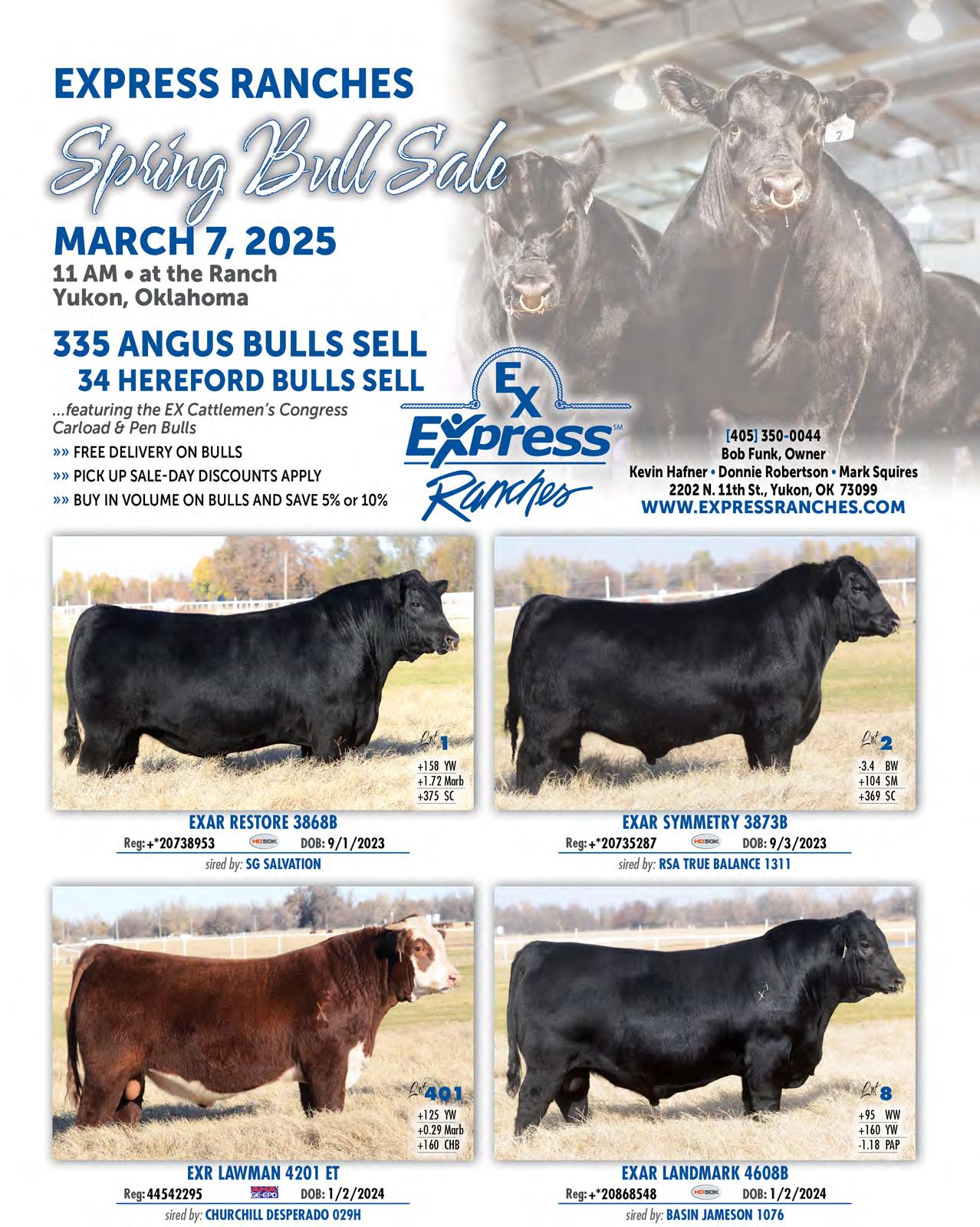





DEPARTMENTS









Magazine Publishing Office 2306 Bluff Creek Drive, #100, Columbia, MO 65201 Phone: 573-499-9162 • Fax: 573-499-9167
Andy Atzenweiler: Editor/Production/Ad Sales 816-210-7713 • E-mail: mobeef@sbcglobal.net
Missouri Cattlemen’s Association MCA Website: www.mocattle.com
Mike Deering, Executive Vice President - Ext 230 Mike@mocattle.com
Aly Francis, Manager of Strategic Solutions – Ext 235 Aly@mocattle.com
Lisa Stockhorst, Administrative Assistant – Ext 234 Lisa@mocattle.com
Missouri’s CattleWomen
http://mocattle.com/missouricattlewomen.aspx
Missouri’s Cattlemen Foundation www.mocattlemenfoundation.org
Jeff Reed, President 903-279-8360 • P.O. Box 35, Williamsville, MO 63967
Anita Vanderwert, President-Elect 573-808-3000 • 4902 Conchero Ct., Columbia, MO 65203
Charlie Besher, Vice President 573-866-2846 • RR 5, Box 2402, Patton, MO 63662
Marvin Dieckman, Treasurer 660-596-4163 • 28998 Hwy JJ, Cole Camp, MO 65325
Deb Thummel, Secretary 660-541-2606 • 12601 Hwy. 46, Sheridan, MO 64486
2025 MC A Regional Vice Presidents
Region 1: Ethan McNeill, 325 McMurry St. Paris, MO 65275 636-544-9943
Region 2: Blake McDonald, 250 Clonts Rd. Sullivan, MO 63080 • 573-205-7914
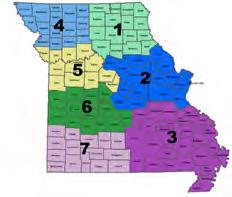
Region 3: Blake Crow, 1910 W. Broadway St., West Plains, MO 65775 • 417-293-9525
Region 4: Dale Buhman, 3751 SW Taylor Rd. Clarksdale, MO 64430 • 816-244-9249
Region 5: Alex Haun, 1031 SW 600 Rd Holden, MO 64040 • 816-345-0005
Region 6: Warren Love, 8381 NE Hwy ZZ Osceola, MO 64776 • 417-830-1950
Region 7: Josh Worthington, 401 N. Dade 231 Dadeville, MO 65635 • 417-844-2601
Region 1- Matthew Jenkins 660-631-0475 matthew@mocattle.com
Region 2 - Doug Mertens 573-489-5261 doug@mocattle.com
Region 3 - Kenneth Ball 417-818-6400 kenneth@mocattle.com
Region 4 - Sarah Kenyon 417-300-2976 sarah@mocattle.com

Missouri Cattlemen’s Leadership College participants and affiliate leadership will gather in Columbia for the 2025 County Leadership Conference. Attendees will dive deeper into the relationship the association has with its affiliates, undergo media training, and learn how to efficiently run a meeting. The second day of the conference is spent in Jefferson City where attendees will have the opportunity to visit with legislators about MCA policy priorities. This year’s event will be held March 3-4. See the registration form on PAGE 24.
FFA Fantasy Feedout Draft Day will occur on Tuesday, February 11, 2025, with the program beginning at 10 a.m. and lunch to follow. The program will take place at Trowbridge Livestock Center Sale Arena in Columbia, Mo., followed by the viewing of the steers at MU South Farms, Beef Research Center. If you or your chapter would like to participate in the 2024-2025 FFA Fantasy Feedout, please visit mocattle.com for more info or see PAGE 87.
The 2025 legislative session is off to a great start with Cowboys at the Capitol meeting in Jefferson City every Wednesday. We are proud of the grassroots efforts reinforced through this weekly activity and see the role it plays in developing relationships with legislators. To find the weekly schedule for Cowboys at the Capitol and when your region or group will be attending, please see PAGE 91.
We are partnering with Show-Me-Select again this year for an exclusive new member promotion drawing. All new Missouri Cattlemen’s Association member will be entered to win in a drawing for a $2,000 credit to a Show-Me-Select Replacement Heifer sale. To be considered a new member, you must not have been an MCA member within the last 12 months. Credit must be redeemed in the same calendar year at any of the spring or fall sales. Learn more on PAGE 88.
Profitability challenge open house will be held in conjunction with the March 29, 2025, Board of Directors meeting. The meeting will be held at MU South Farm at 10 a.m. Steers competing in the profitability challenge will be on display for producers to view at the farm and lunch will be provided. Learn more about the profitability challenge by visiting mocattle.com.
Albert LaRose, Blue Eye, MO
Alexis Harris, Warrenton, MO
Beth Walter, Fulton, MO
Chase Thomas, Hartsburg, MO
Conor Stockton, Aldrich, MO
Evan Stockton, Aldrich, MO
Grace Lloyd, Ellington, MO
Greg Cline, Plattsburg, MO
Gregg & Janet Fritter, Nevada, MO
Jim Rehagen, Diamond R
E quipment, Freeburg, MO
Josh Peak, Columbia, MO

Landon Hutchison, Harwood, MO
Mark & Sandra Kloeppel, Dixon, MO
Raelynn Kelley, Kahoka, MO
Ray Crum, Seven C’s Ranch, Dardenne Prairie, MO
Reggie Powers, Joplin, MO
Rudy Willis, Rothville, MO
Sarah Darling, Kirksville, MO
Shelby Powell, Palmyra, MO
Tim Farrell, Cabool, MO
See the MCA Membership Form on page 93.


What a week we have had! Beginning with the Inauguration of Governor Mike Kehoe followed by the 57th Annual Missouri Cattle Industry Convention. Inauguration was very well attended by our leadership team and cattlemen across the state. We were able to meet with our statewide elected leaders and members of both the house and senate to discuss issues facing cattlemen.
Our annual convention was a huge success, and I am very appreciative for all who attended and made it such a success from the convention committee to the staff. Thank you. We were able to pass policies, decide legislative priorities and vote in our leadership. I also want to thank Representative Aaron Crossley for his phenomenal performance singing the National Anthem at the last minute for our annual banquet.
Through the governance task force, I was appointed to chair by MCA Past President Chuck Miller, we were able to get our bylaws changes voted in at our annual meeting. I want to thank those who devoted themselves to this task force: Nathan Isakson, Jeff Branch, Adam McGee, Robert Brundage and Keith Stevens. Please be on the lookout for an email seeking applicants for those councils coming soon.
Also changed was the treasurer position, which is now an appointed position by the president and confirmed by both the executive committee and the board of directors. Please let me know if know of anyone interested in this position. I want to ensure the individual we place in this role has a vast understanding of the financial world and will be a good steward of the resources our members have worked so hard to accrue.

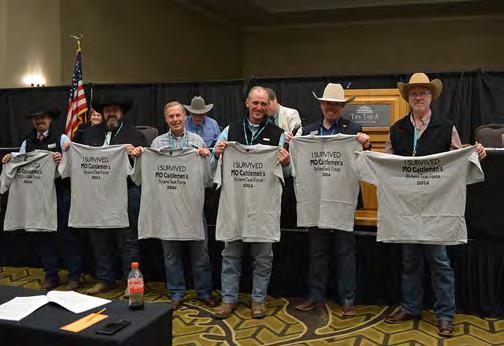
Cowboys at the Capitol kicked off on January 22 and continues throughout the legislative session. While there are scheduled region dates, you are welcome to attend any Wednesday that works for you. Our policy priorities for the coming year are water rights, solar energy taxation and eminent domain reform, but as always, we will shift our efforts if other policy we support gains traction.
I spoke in my remarks at our annual meeting about a patch I wear on my hat, it is +x which stands for “positive times”. I hope we can carry out that mentality as we conduct ourselves this year and into the future. It is a great time to be a cattleman and I look forward to the year ahead. As always, make sure you have a few good stories to tell.
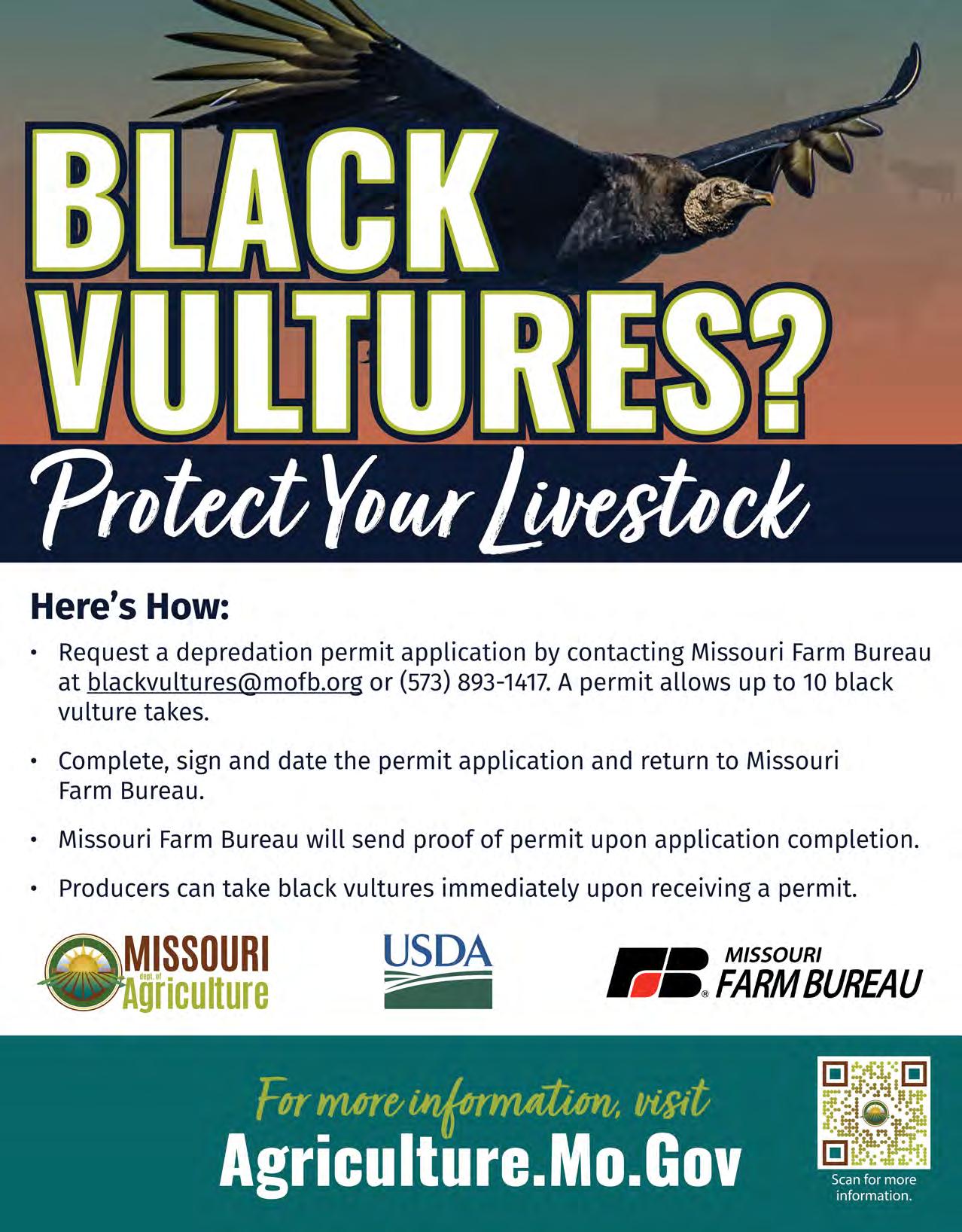
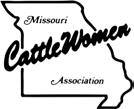
Howdy! I’m your new Missouri CattleWomen’s President and I look forward to working for all of our members. My husband, Jason, and I own Poor Farms Cattle in Howell county. We are a commercial cow/calf operation with Salers and Angus genetics. We also own a few registered Salers and Angus bulls and cows. We have two amazing kids, Maddie and Cooper. Maddie is a freshman in college and Cooper is a sophomore in high school where I work my “day job” as one of the secretaries. As parents, Jason and I wanted to feed our kids the best possible meat that we could find. We originally started out raising our own meat chickens. In 2017, we decided to start raising beef for our family.
President: Jennifer Poor
417-372-0227 • poorfarmscattle@gmail.com • Pomono
President Elect: Darla Haines
573-473-6013 • darlahaines2003@yahoo.com • Mexico
Vice President: Mandy Weigand 660-909-6781 • weigandranch@hotmail.com • Warrensburg
Secretary: Terry Bettels
660-424-3444 • cbettels55@gmail.com • Butler
Treasurer: Mary Kay Lyle
816-387-1930 • marykaylyle@gmail.com • Savannah
Past President: Marsh Corbin 660-232-1836 • oldtrailsregion@gmail.com • Dover

As producers, we believe in order to get quality beef for our family, we must focus on genetics and nutritional needs for our cattle. For genetics, the primary things we look for are docility and good milk numbers. Although we know there is more to it than just that. As far as nutritional needs go, we have teamed up with a feed consultant and have found a great equation for our herd. Even with focusing on genetics and nutrition, we are constantly researching and learning new things to make our herd the best it can be.
When I first joined MCW, I really had no idea what MCW did. I knew they had meetings at the annual Missouri cattle industry convention and was highly involved at the Missouri State Fair; however, other than that I wasn’t sure what they did. Once I started getting involved, I learned that it isn’t just a “hen party.” I found that MCW members get things done and they do it all while having fun!
MCW members are tough yet tender. They are sometimes quiet, but know when to speak up for an industry they wholeheartedly believe in. Most of us are wives working alongside our husbands. Some of us are widows carrying on the family farm after our husbands have passed. Some of the members are daughters or nieces who had a family member start their love, or addiction in some cases, of cattle with that first bottle calf. Most of us spend our days working off the farm only to come home to take care of the house, kids, family, dinner, animals, etc. After all of that, we work to volunteer for an industry we truly love. You will see
Ingredients:
1 beef Bottom Round Roast (about 3 pounds)
2 tablespoons olive oil
1 tablespoon finely chopped fresh rosemary
1 tablespoon minced garlic
1-1/2 teaspoons finely chopped fresh basil leaves
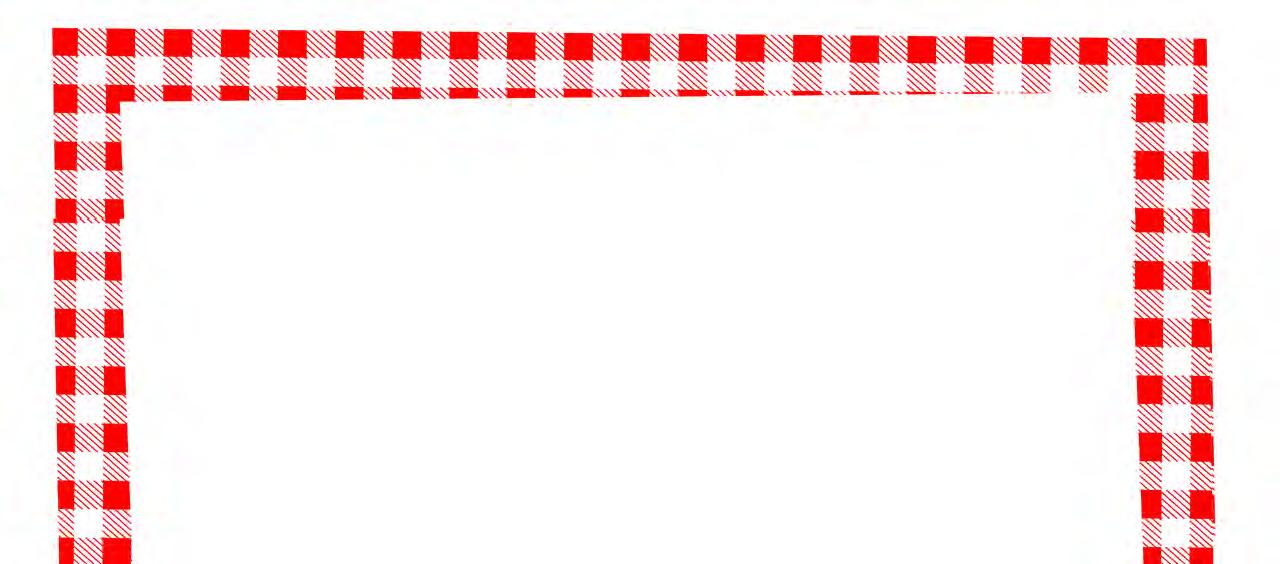
1 teaspoon salt
1 teaspoon dried thyme leaves
1 teaspoon freshly ground black pepper
3 cups reduced-sodium beef broth
1-1/2 cups water
1. Preheat oven to 325°F. Mix together oil, rosemary, garlic, basil, salt, thyme and pepper in small bowl. Set mixture aside 5 to 10 minutes.
2. Place beef Bottom Round Roast on baking rack in tall-sided roasting pan. Rub oil mixture on roast, covering all sides. Pour broth and water in roasting pan. Insert oven-safe thermometer into center of roast. Place roasting pan in center of 325°F oven.
3. Roast 1-1/4 to 1-3/4 hours. Remove roast when meat thermometer registers 145°F for medium rare; 160°F for medium. Transfer roast to carving board; tent loosely with aluminum foil. Let stand 10 minutes. (Temperature will continue to rise about 5°to 10°F.)
4. Carve roast into slices; serve with cooking liquid or as a sandwich, topping with your favorite cheese.

us at the Capitol making connections with our elected officials. You will hear us on the other end of the phone making calls for a membership drive for Missouri Cattlemen’s Association affiliates. We are at the board meetings working on policy planning for the next big event or taking care of the current pressing issue. We do
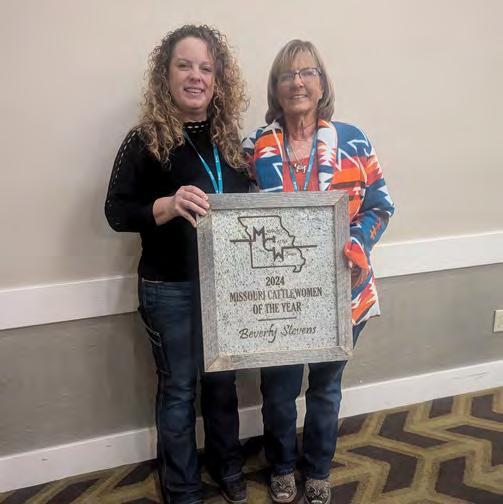
all of this, because we care. We want to hear from you and we want to know what you are concerned about. If you have any questions, concerns, or ideas on how to make our association better we want to hear from you. Our contact information is listed in every magazine.
Cowboys at the Capitol will be starting soon. Trust me when I say I understand how hard it can be to make it to one as we start calving this month, but it is worth the time away from the farm and possibly your day job. I encourage you to take the time and go to Cowboys at the Capitol and meet with our legislators. You never know, you may find common ground with someone you least expected. Another fun event that comes to mind for 2025 is the Annual Steak Fry in June. This is always a fun, laid back event full of good food and getting to see old friends. Jason and I use the Steak Fry as an opportunity to have a date weekend. If you can get away for the night, you should! It’s good for your farm, family and industry.
Lastly, when I say I want to hear from you, you can guarantee that is the truth. My goal for 2025 is to be one of your “go-to” people for all things in the cattle industry. If I do not know the answer, I will find it.
One by one, 22 names were read at the 57th Annual Missouri Cattle Industry Convention on the evening of Saturday, January 18. The names were read slowly and deliberately. When the last name was read, the more than 500 people in attendance joined in a moment of silence to memorialize the members and friends of this association who passed away in 2024. I knew some of them, but not all. The youngest among them was 52 years old, while the oldest was 94. As I stood there, I became keenly aware that we are all on borrowed time. At any moment, any one of us, from the oldest in the room to the youngest, could be called home. Tomorrow is not guaranteed.
At our annual convention, there was much talk about the next generation and ensuring we repopulate the land with new faces. What isn’t talked about enough is how to get there. I personally believe transition planning –above all else – is the single most important thing we can do as cattle producers to ensure the future of this industry remains vibrant and in good hands. The United States Department of Agriculture shows that more than two-thirds of agricultural ground is controlled by someone nearing 60 years of age. Control of a third of that land will change hands in the next 10-15 years. According to Wesley Tucker, University of Missouri Extension, since 1974, younger people have owned less and less agricultural land and fewer small businesses – the fabric that holds rural communities together. This alone emphasizes the need for transition planning.
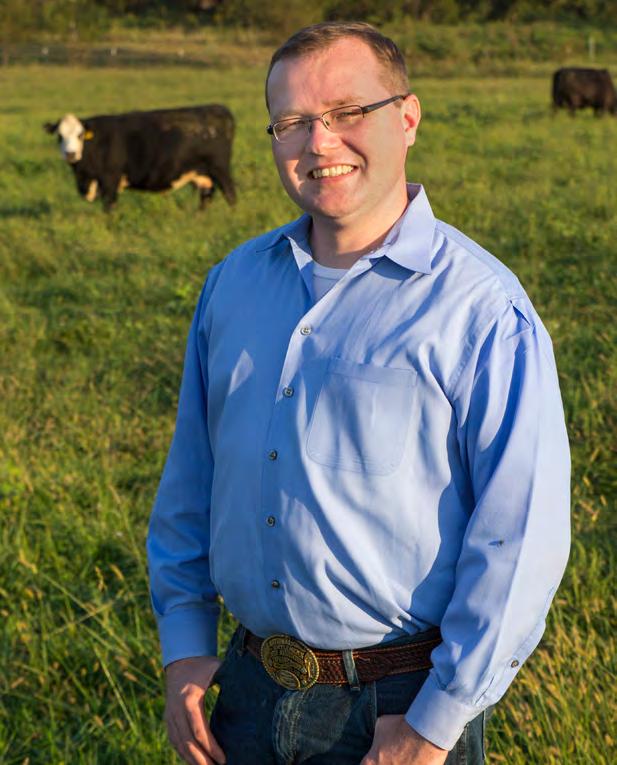
From attorneys to investment firms, many businesses offer transition planning. The University of Missouri Extension also provides consultation at no cost. I encourage you to start this process. If you already have a plan, maybe it is time to review it. Most experts recommend reviewing your will and transition plan every three to five years or whenever a significant life event occurs, such as marriage, divorce, birth of a child, major asset purchase, or a substantial change in your financial situation. Too often, transition planning starts the day after the funeral as was the case when my parents passed, leaving my sister and I in a whirlwind of confusion and uncertainty.
Most people don’t want to think about preparing for death. Like most people, I love the illusion of immortality. Of course, no matter how hard we try to stop the clock or to sweep the shadow of death from our doorsteps, it is the one thing we are all guaranteed. So, despite how uncomfortable you may feel about contending with your eventual passing, pre-planning for the end of your life needs attention. If we are truly serious about empowering the next generation, this is one thing that can actually make a real difference. Let 2025 be the year you make this a priority for you, the next generation and the future of our industry and our rural communities.
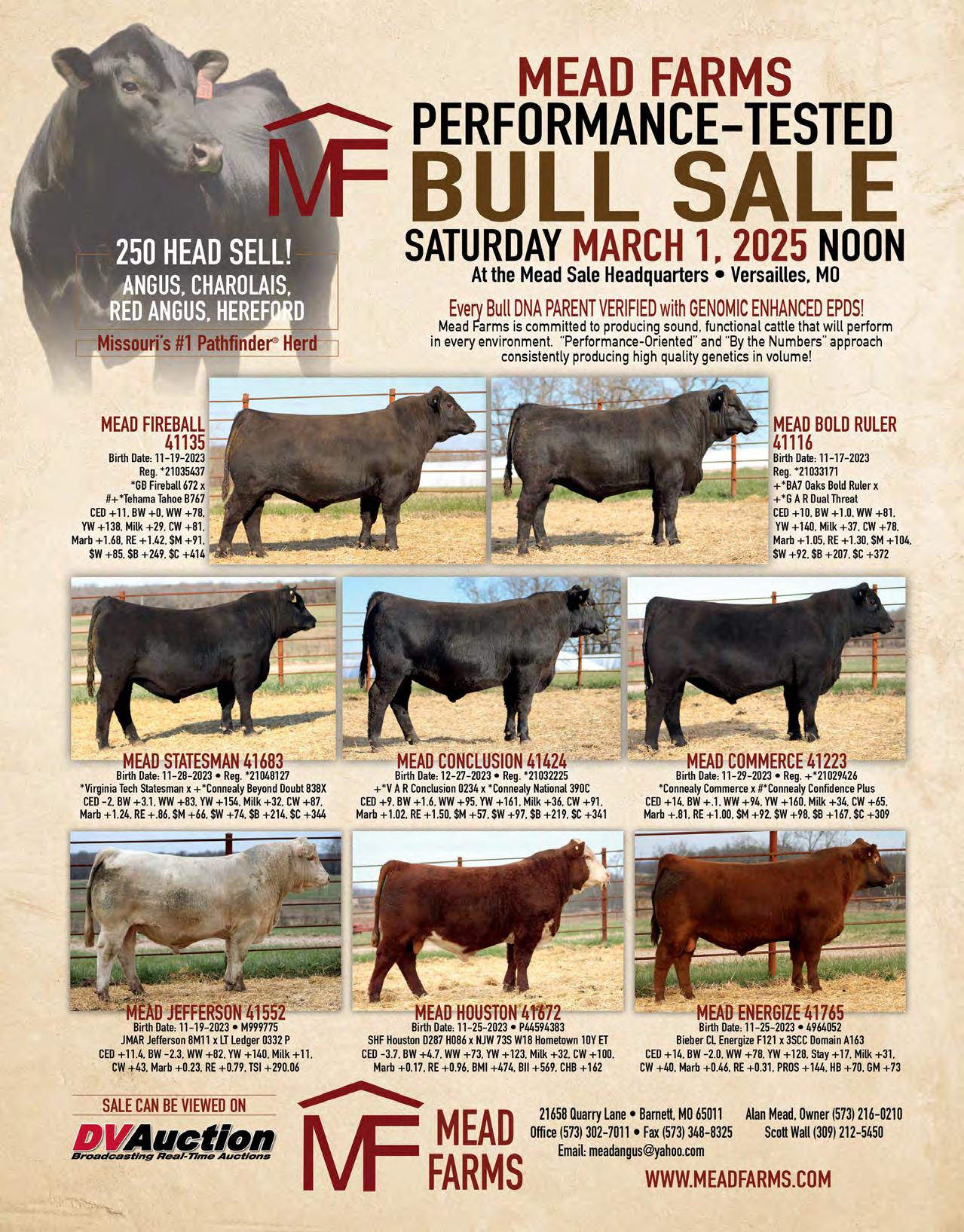
by Anita Vanderwert, MCA President-Elect
What an exciting convention! The halls and meeting rooms were buzzing with good conversations and meaningful discussions about the beef industry. If you missed it this year, join us for the fun next year.
Membership is vital to our association. There isn’t any better way to assure our state legislators we are speaking on behalf of all cattlemen in our state than by renewing your membership and getting another to join. More members means more power in the hallways of the Capitol when we fight for our policies and priorities. For a base cost of $70 each year, it’s a small investment for the return. Don’t delay if you haven’t renewed your membership or asked a fellow cattleman to join.
Spring is the time to get involved with your county association leadership teams. 2025 starts with numerous county scholarship banquets and meetings. These are a great way to become involved and recruit friends and neighbors to join MCA. You can go to mocattle.com if you don’t know when your county is meeting or when a neighboring county is meeting.
When you attend, ask everyone at your table if they belong to MCA. If they don’t, show them how to become a member online or hand them a membership card. We usually have membership applications at all meetings sitting at the front table. If they hesitate, ask them to join us every Wednesday for Cowboys at the Capitol. They can see their association and members at work walking the halls and talking to our leaders. If you haven’t joined us in a while this is a good year to become more active.
2025 is starting off to be a great year. This is our year to grow our association, get more people involved and recruit at least one new member. Let’s make MCA even stronger in 2025. This is going to be a fun and informative year. I’m looking forward to seeing you at the next event!

Region 1 VP - Ethan McNeill
Region 2 VP - Blake McDonald
Region 3 VP - Blake Crow
Region 5 VP - Alex Haun
Region 6 VP - Warren Love
Region 7 VP - Josh Worthington
Region 4 VP - Dale Buhman At-Large Rep. - Jarrod Simpson




As spring approaches, now is a good time to think about the fertility needs of your pastures and hay fields. One of the best ways to start this process is with a soil test. Having a soil test will provide you with a better understanding of what your current soil fertility and pH are and if you need to provide for expected crop removal or if you need to establish a plan for removal plus building your Phosphorus (P) and Potassium (K) levels.
Soil testing can be done either as a composite sample, where multiple cores are taken from a field and combined or grid sampling, where a field is divided into smaller sample areas, and you receive results for each grid. While composite sampling does provide you with benchmarks, grid sampling provides a more detailed look at your field and can be useful if there have been different management practices in that field.
The soil pH plays a crucial role in both nutrient availability and plant growth. Nutrients in the soil are most available when the pH is between 6.0 to 7.0 and this is the range that is acceptable to most plants. A soil test is the best way to determine if lime is needed. When your fields need lime check with your supplier as the Effective Neutralizing Material of lime varies between suppliers and will determine the application rate.
Your soil test may indicate certain nutrients are low in the soil and a build program is necessary to bring soil levels up to an optimum level. In this case, you will need to apply the removal rate each year and develop a plan to build the soil levels. The build process does not need to occur in one year and can be spread over several
years, adjusted based on fertilizer and or livestock markets.
Micronutrient recommendations are typically made on our row crop fields but may be overlooked on hay and pasture fields. Micronutrients play a key role in plant growth and development, and should be considered when you are making fertilizer applications. Ask for those results from your soil test provider when delivering your soil sample.
Identifying how the field will be utilized is another consideration. Hayfields and pastures may need to be treated differently based on yield goals, and the plant species in the field. Pastures or hay fields with only cool season grasses like brome, fescue, orchard grass or timothy plants will require more nitrogen than a field that contains both grasses and legumes. Generally, nitrogen rates can be reduced if a field contains 2530% legumes. Warm season grasses removal rates are different from cool season grasses, plan accordingly when building your fertility plans. Other considerations might be if you plan to hay multiple times in a season, hay and then graze or plan to stockpile for winter grazing. Split applications of fertilizer in any of these situations may help maximize your yields.
It’s not too late to take soil samples this spring. The information you receive can help boost your yields and make the best use of your dollars spent. The Missouri Cattlemen’s Regional Grazing Coordinators are available to help interpret your soil test and help with other grazing questions as well. Reach out to us using the contact information listed below.
Matthew
Doug
Kenneth
Source: American Angus Association
A deep respect for the history of the Angus breed, paired with a passion for the future – Casey Jentz, recently named chief operating officer of the American Angus Association®, will bring to his new role.
“Angus is the heartbeat of the beef industry,” Jentz said. “The people before us have done a great job of leading Angus and positioning the breed as a leader in the industry. We can build on that and push forward into the future.”
For more than 10 years, Jentz has served as an Angus regional manager in Indiana, Illinois, Michigan and Wisconsin. During that time, he worked directly with Association members helping them understand Association programs, market their cattle with Angus Media services and answer their questions.
In his new role, Jentz will be responsible for direction and strategy of several departments, including member and field services, communications, performance programs, commercial programs, and events and junior activities.
“We are thrilled to promote Casey to this new role,” said Mark McCully, chief executive officer for the Association. “Not only does he have years of experience working with Angus breeders in the field, but his knowledge of the Association and its programs will also be invaluable as COO. In particular, I love Casey’s unwavering commitment to the breed.”
It’s the Angus family that drives Jentz. “The Angus business is a combination of great people and great cattle where great things can happen,” he said.
Jentz is a fourth-generation Angus breeder who was a National Junior Angus Association board member from 2004 to 2006. His daughter, Sydney, is following in his footsteps with excitement for the breed. This is her third year as an NJAA member and his younger daughter, Savannah, is not far behind.
“There are a lot of things that get me excited with possibilities for the future,” he said. Whether that’s seeing a great Angus cow, meeting

a new member or seeing the future through the eyes of a junior, Jentz is looking forward to his new role.
Prior to working for the Association, Jentz was the general manager of a farm in Wisconsin and managed a multi-state sales territory for an animal health company.
Jentz will assume his new role on March 3 and will continue to work sales and serve breeders in his region through the transition. He and his wife, Kayla, and their two daughters will be relocating to St. Joseph, Missouri in the coming months. A position for a new regional manager in Jentz’s territory has been posted on Angus. org/careers.
“I am really looking forward to continuing to work with the great members of this Association in a new way,” Jentz said.
For more information about the American Angus Association, please visit angus.org.
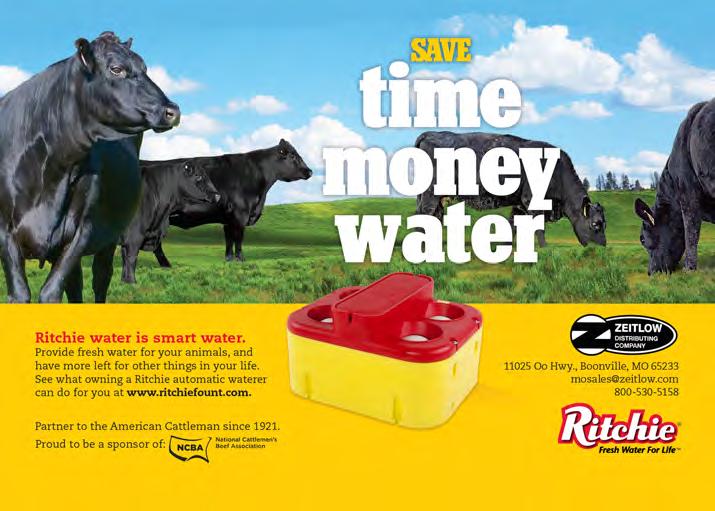
By Pat and Patty Wood, MCA Beef House Managers
Our winning bidder at the 57th Annual Missouri Cattle Industry Convention live auction at Margaritaville Lake Resort held January 17-18, 2025, was BTC Bank, the number one agriculture bank in Missouri, for the Custom Metal Art Sign at the Missouri Cattlemen’s Association Beef House Patio Entrance.
Thanks to the generosity and sponsorship of LAG Industries, the Beef House Patio Entrance will continue to have new Custom Metal Art Signs on display on a yearly basis.
“Since we share a common vision and a continuing commitment to work together for the good of agriculture, we appreciate the opportunity to partner with the Cattlemen,” said the Brackman’s
The Brackman’s of LAG Industries in La Monte, Missouri have partnered with the Beef House to bring a unique opportunity to the highest bidder the chance to put your name or business on a 9” x 48” metal sign. Guidelines include the Custom Metal Art Signs will be on display for a year and will become the buyer’s possession at the end of the year, buyer cannot be a competitor of the MCA Beef House or LAG Industries, and design details will be worked out by the buyer in cooperation with LAG Industries and the Beef House.



We auction the patio entrance/north-side sign at each convention with the proceeds to benefit the Missouri’s Cattlemen Foundation whose mission is to promote the educational development of rural youth by aiding injured children, providing farm safety training, leadership programs, and scholarships. Thank you BTC Bank for your bid and support at Missouri’s Cattlemen Foundation auction!
We will auction the Beef House patio entrance/southside sign opportunity at the MCA Past-President’s Steak Fry and PAC Auction held in June. The proceeds will benefit the MCA’s Political Action Committee whose purpose is to be involved in the political process by supporting those elected officials who support the beef industry as well as those issues that directly impact the nature of the beef business. Mark your calendar now for June 14, 2025, and be ready to make a bid on this unique opportunity for a Custom Metal Art Sign with your name or business to be displayed June 2025 to June 2026 at the MCA Beef House Patio Entrance and then take it home to display on your farm or business!
Did you know that LAG Industries also designed and makes the MCA Lifetime Members Custom Metal Art Signs? A big thanks to Bart & Brenda Brackman, Brad & Nicole Brackman & family and employees for time, energy, talents and partnership! If you want to know more about LAG Industries, go to lagind.com, LAG Industries on Facebook, or call (660) 347-5413.
Thought for the Month: “Roses are red, violets are blue; The steaks on the grill, waiting for you!”

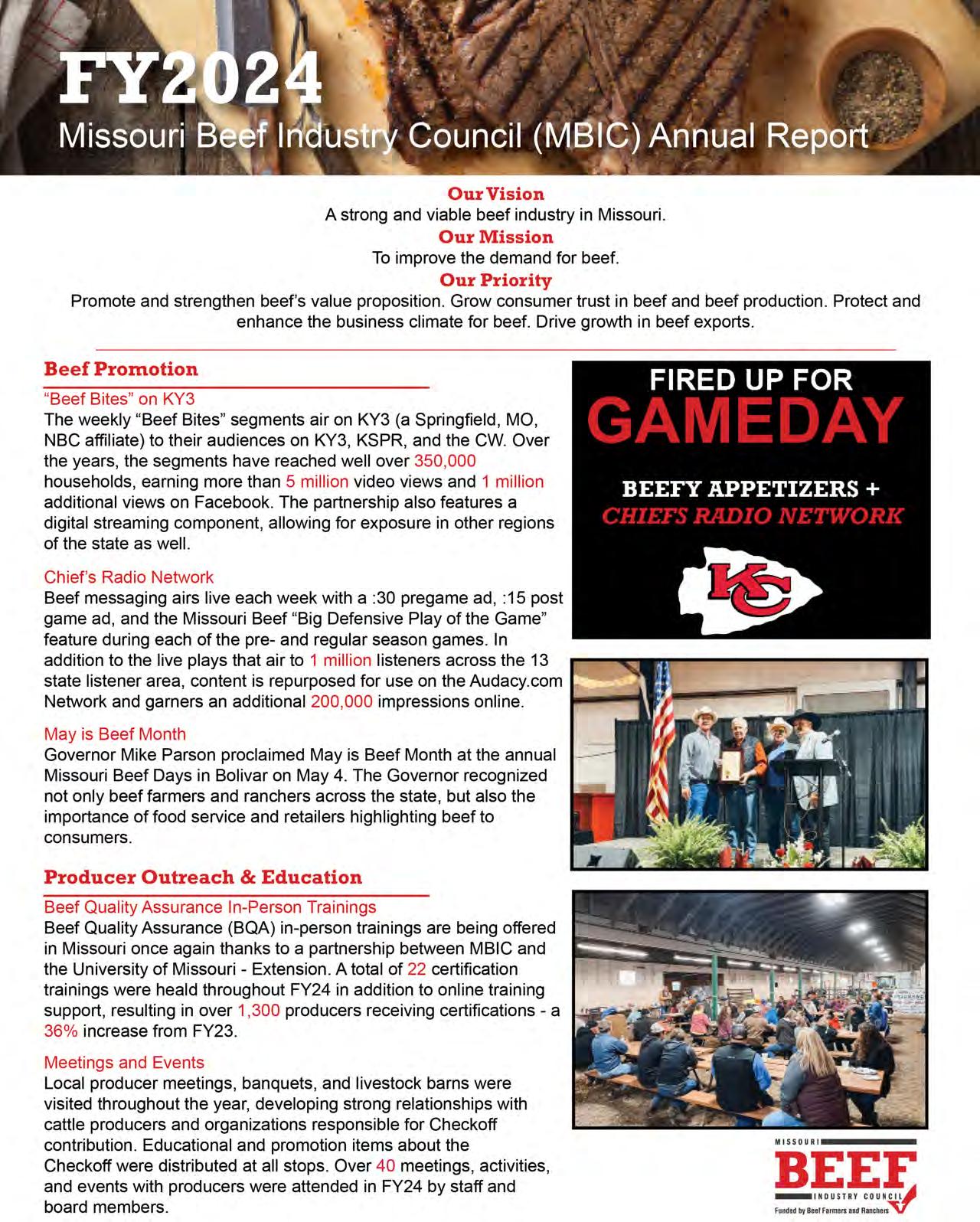
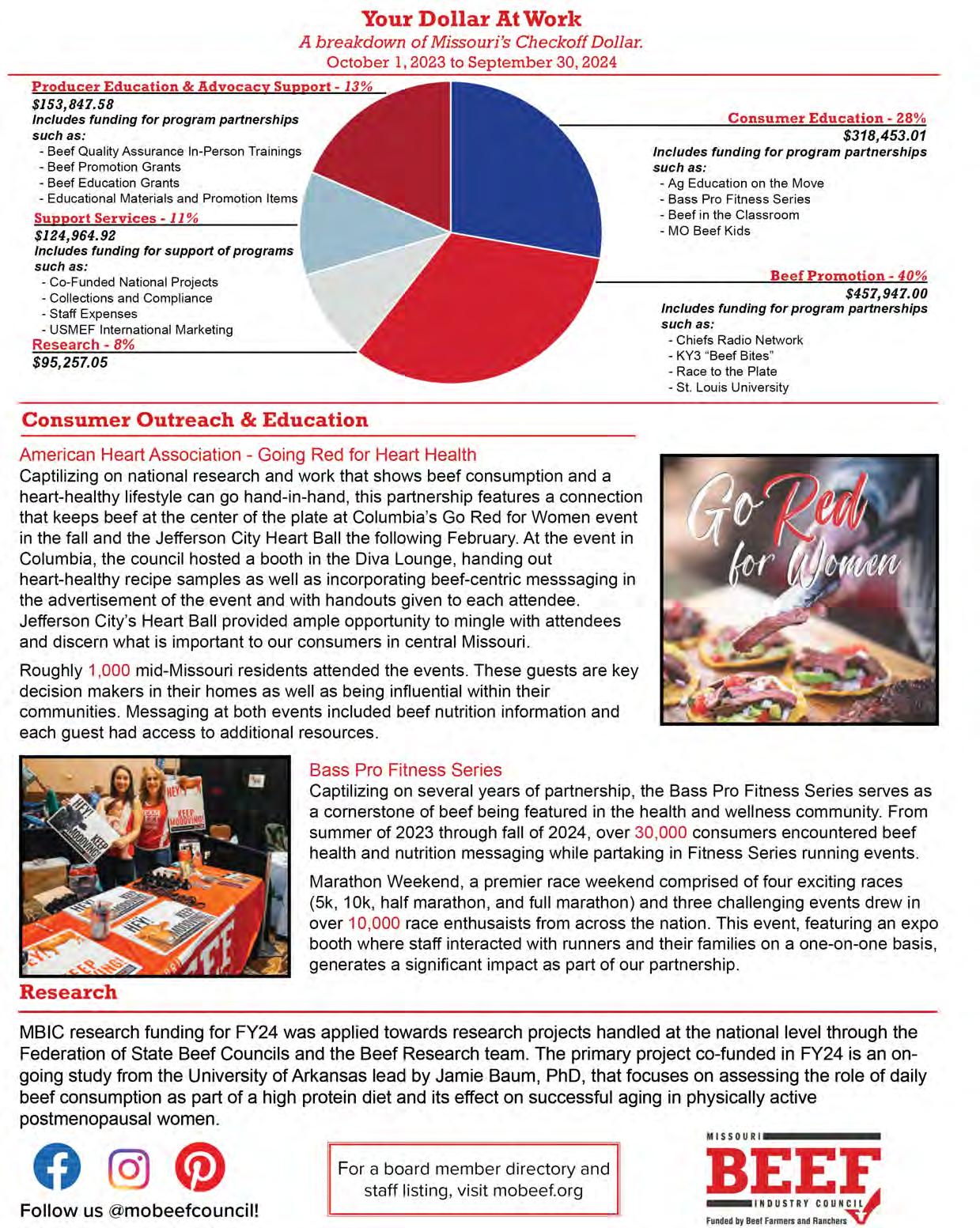
Source: USMEF
November exports of U.S. red meat posted year-overyear gains across all categories, according to data released by USDA and compiled by the U.S. Meat Export Federation. U.S. pork exports remained on a record pace, while beef and lamb shipments also increased substantially from November 2023.
Pork exports already top annual records in Colombia, Central America
Pork exports totaled 272,141 metric tons (mt) in November, up 5% from a year ago, while export value increased 6% to just under $783 million. These results included an especially strong month for pork muscle cut exports, which increased 6% to 221,652 mt. Muscle cut export value was the third highest on record at $671.4 million. Export value per head slaughtered was $72.20 in November, up 9% from a year ago and the highest since April.
“Another terrific month for pork demand in Mexico and throughout the Western Hemisphere,” noted USMEF President and CEO Dan Halstrom. “It was also encouraging to see exports trend higher to Japan and sustain strong growth in Oceania and Southeast Asia.”
Through the first 11 months of 2024, pork exports were also up 5% year-over-year in volume (2.76 million mt) and 6% in value ($7.85 billion). When December results are available, exports will exceed 3 million mt for the first time, topping the previous high (2.98 million mt) reached in 2020. Export value will exceed $8.5 billion, easily surpassing the 2023 record of $8.16 billion. Pork exports to Central America and Colombia already set

annual records and exports are on a record pace to Mexico and the Caribbean. Export value will also be the highest on record for Oceania.
Key Asian markets, Mexico, Egypt push November beef exports higher
November beef exports increased 10% year-over-year to 109,288 mt, while value climbed 11% to $872.7 million. Export value per head of fed slaughter equated to $428.70 in November, up 13% from a year ago and the highest since June.
“Despite continued economic headwinds in Asia, November demand for U.S. beef strengthened in South Korea, China and Taiwan, and exports were fairly steady to Japan,” Halstrom said. “The strong performance in Mexico and outstanding demand for variety meat in Egypt were also critical for bolstering carcass value.”
November beef exports also increased substantially year-over-year to the Caribbean, ASEAN and Central America. For January through November, beef exports increased 5% in value ($9.56 billion) from the same period in 2023, despite a 1% decline in volume (1.18 million mt).
Mexico fuels growth in November lamb exports
November exports of U.S. lamb totaled 130 mt, up 13% from the low volume posted a year ago, while value increased 8% to $881,000. Growth was led by larger shipments to Mexico, while exports also edged higher to the Bahamas and Netherlands Antilles. Lamb muscle cut exports to Mexico totaled 69 mt, up 35% from a year ago and the highest in five months.

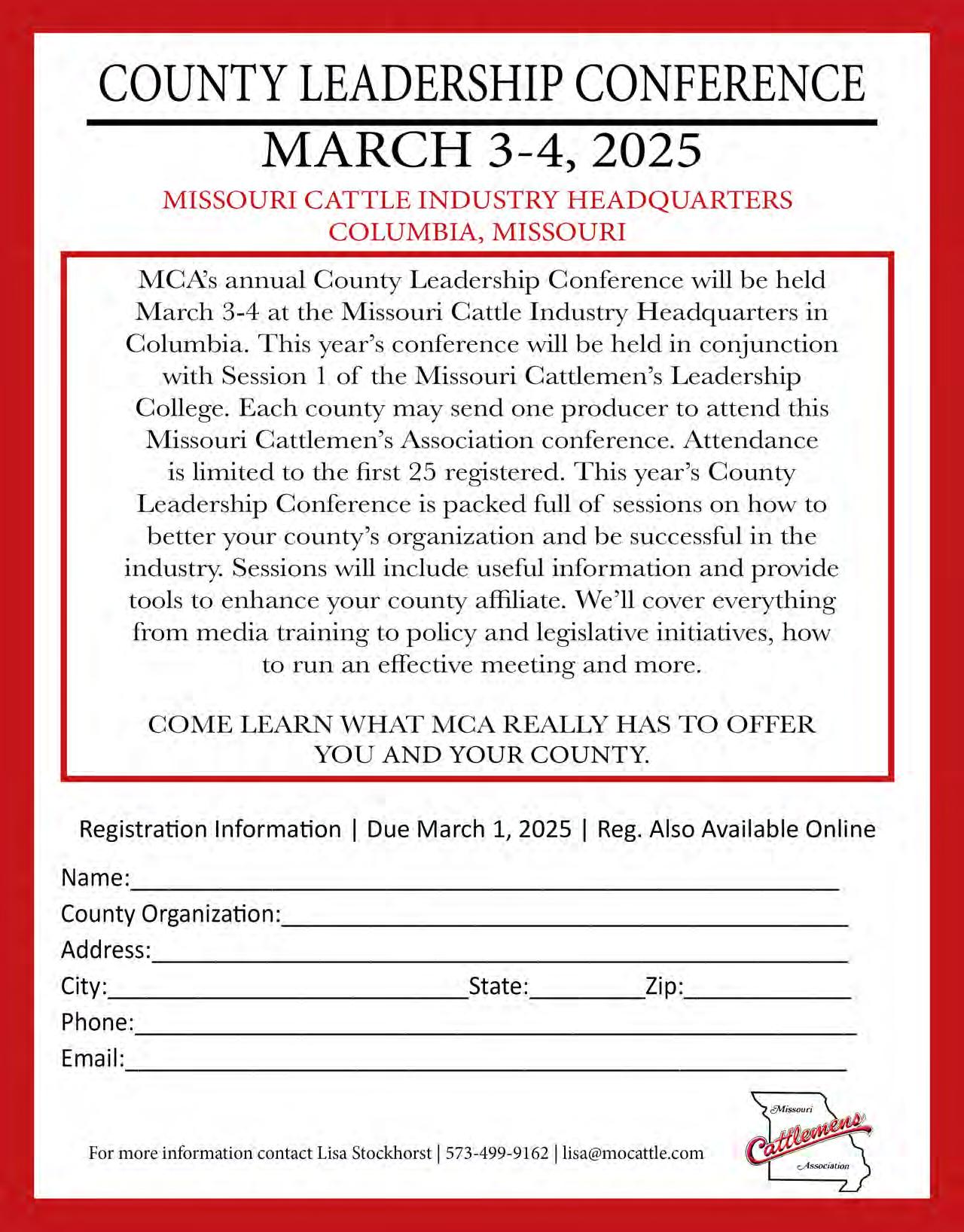

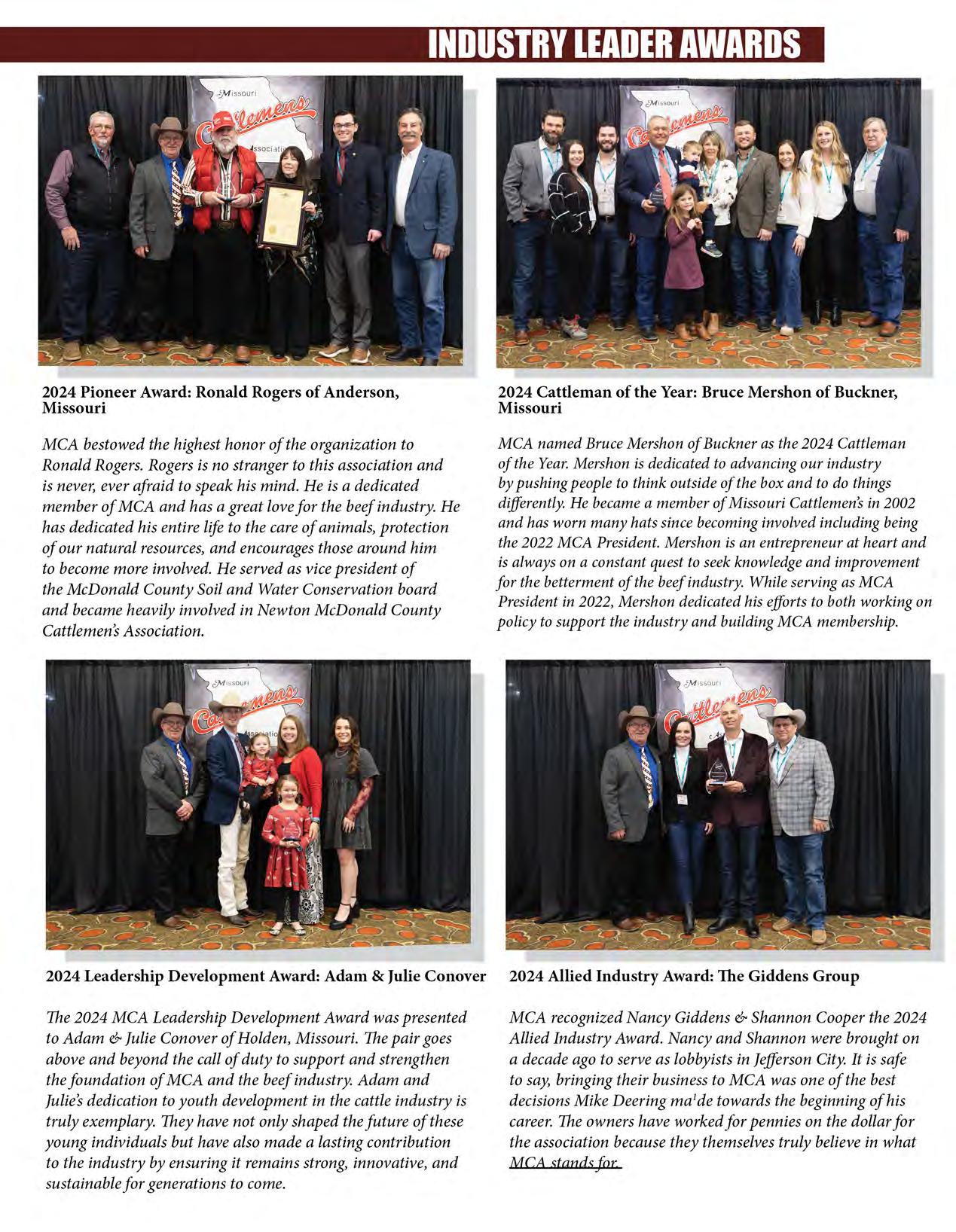




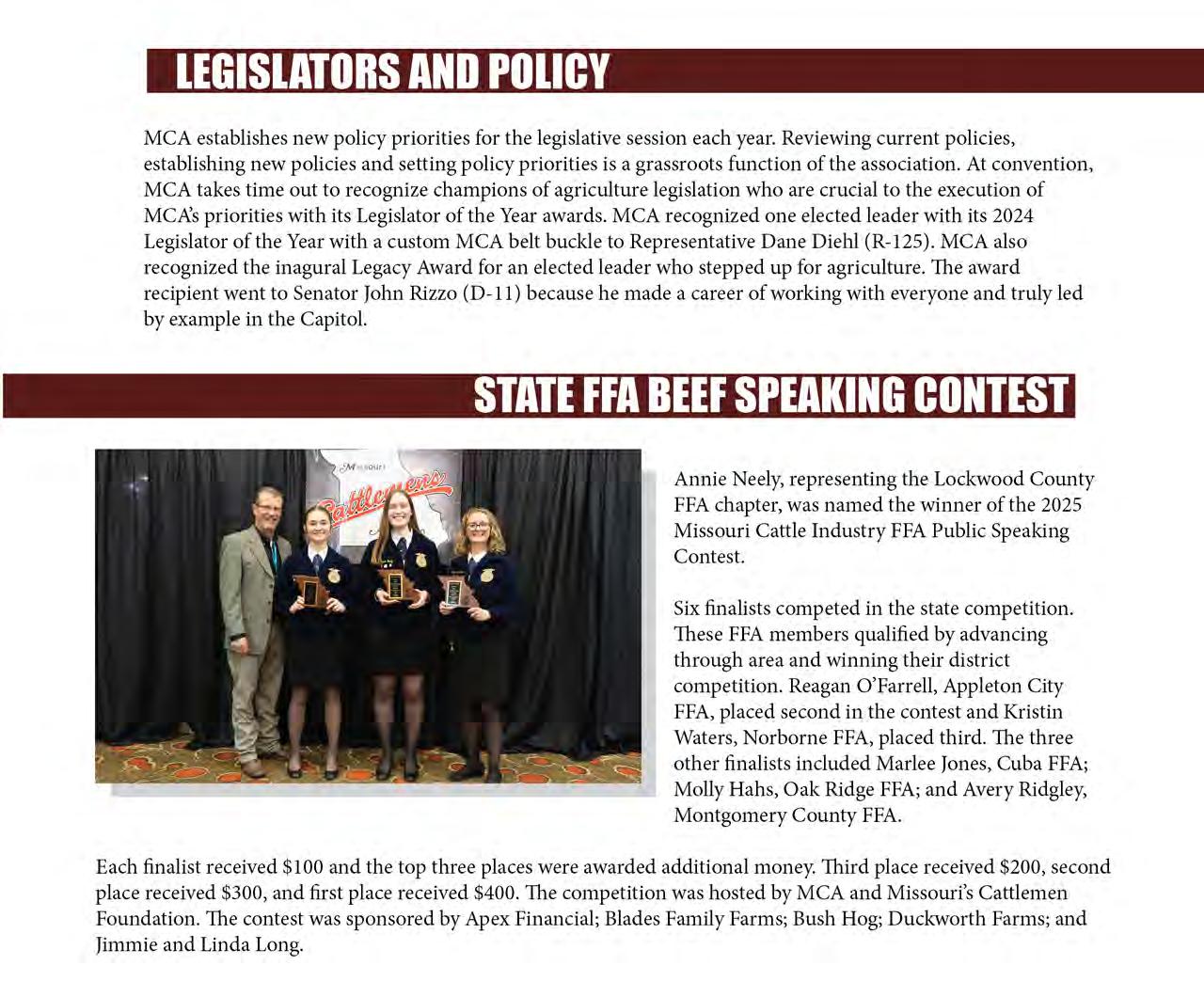

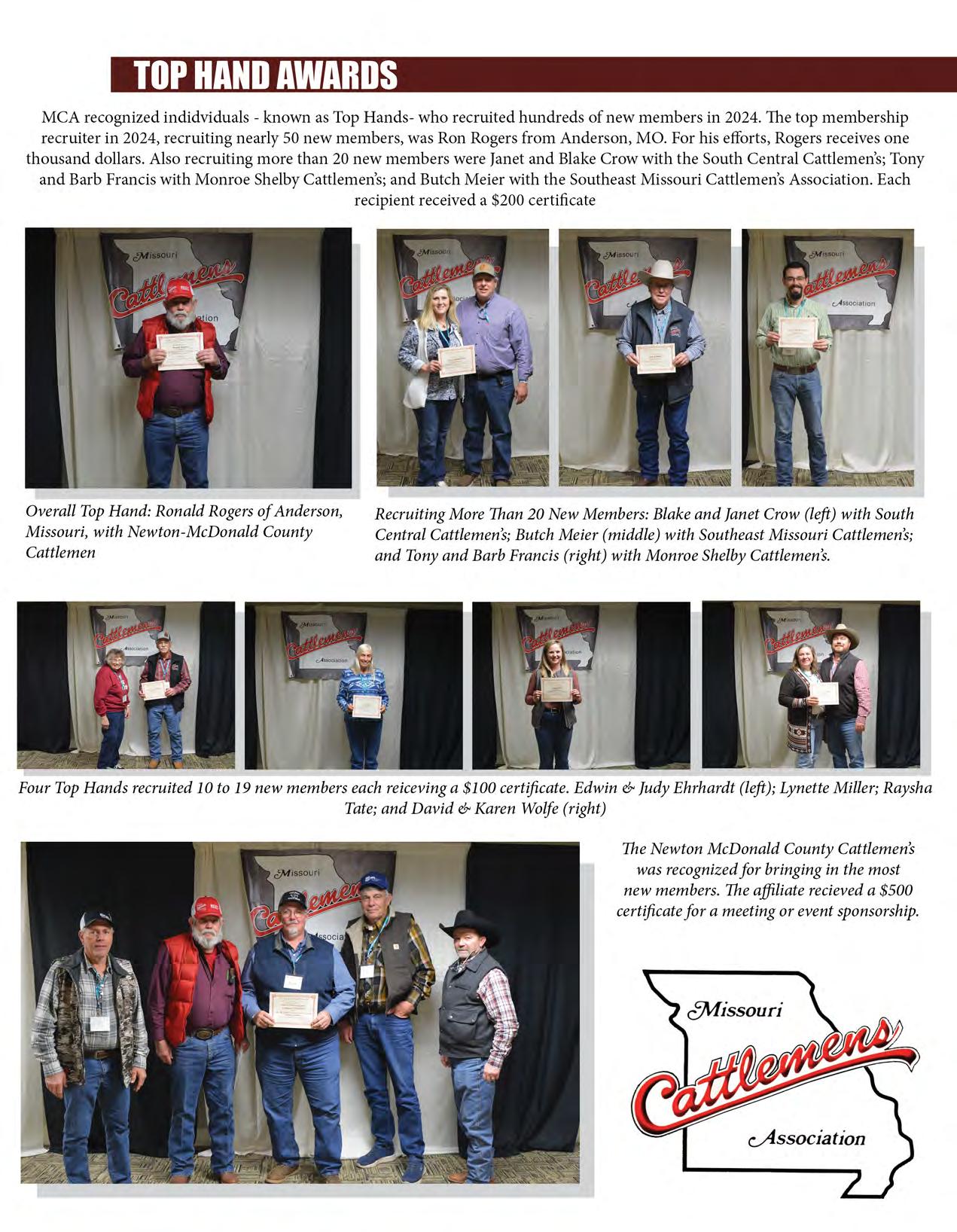

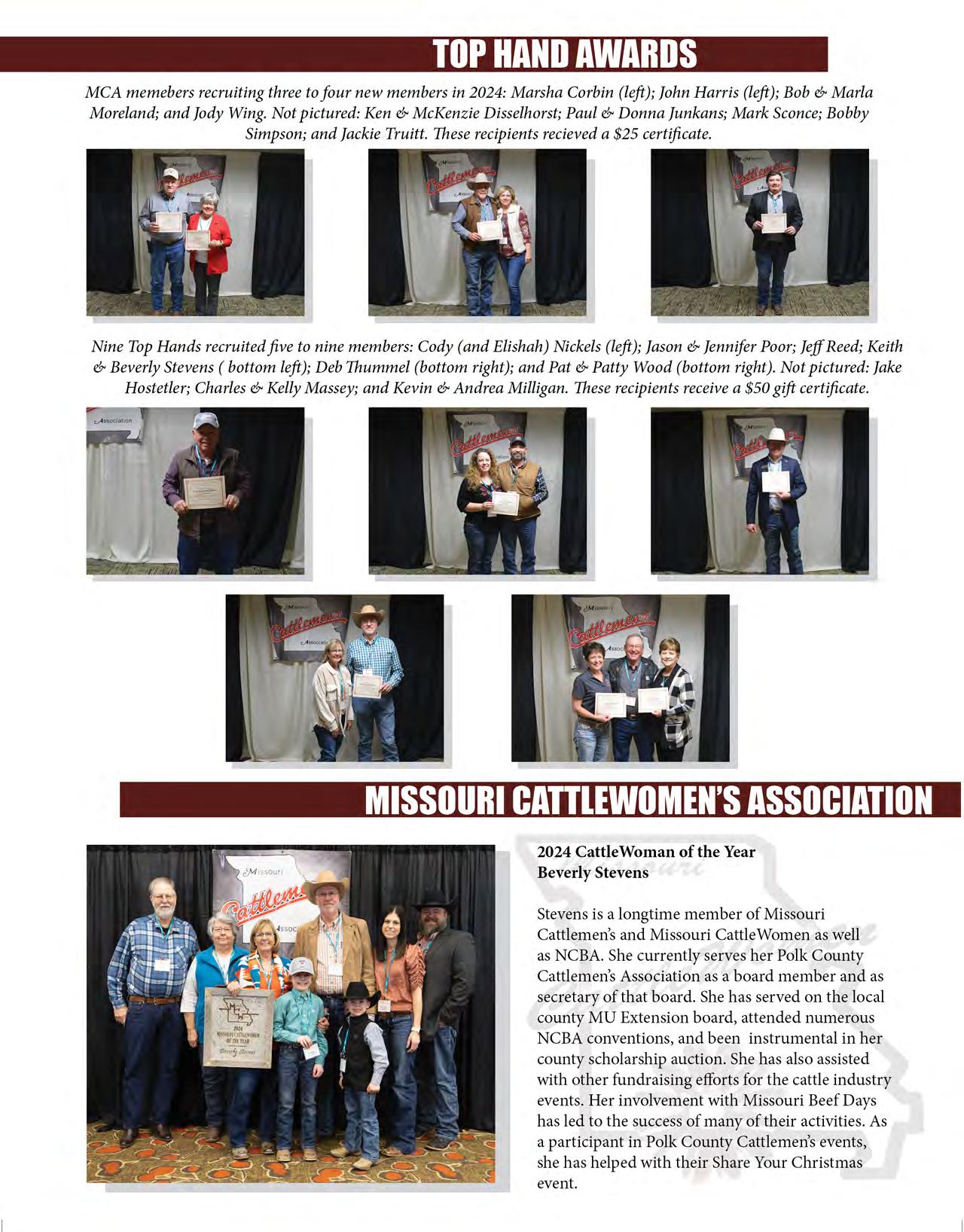

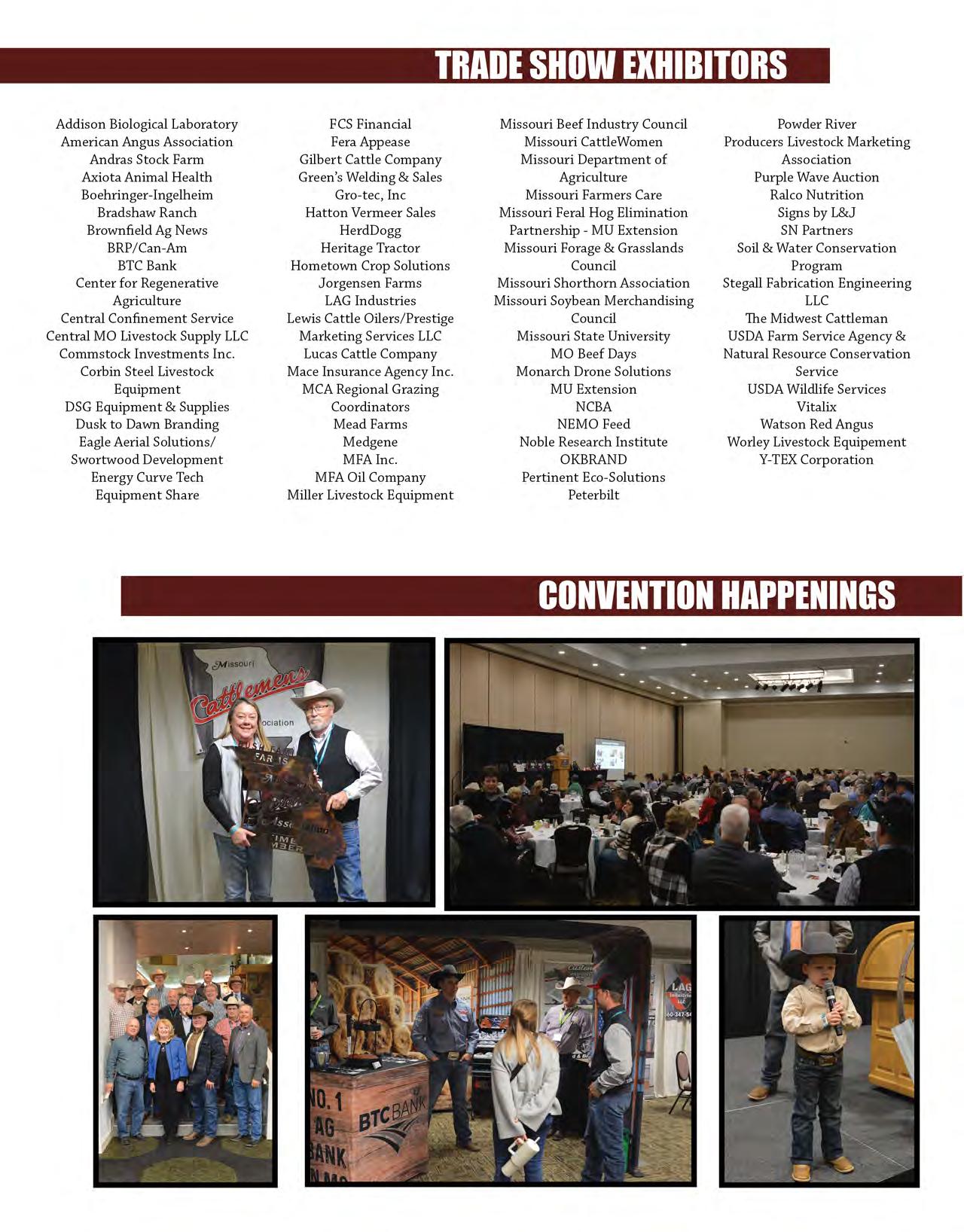

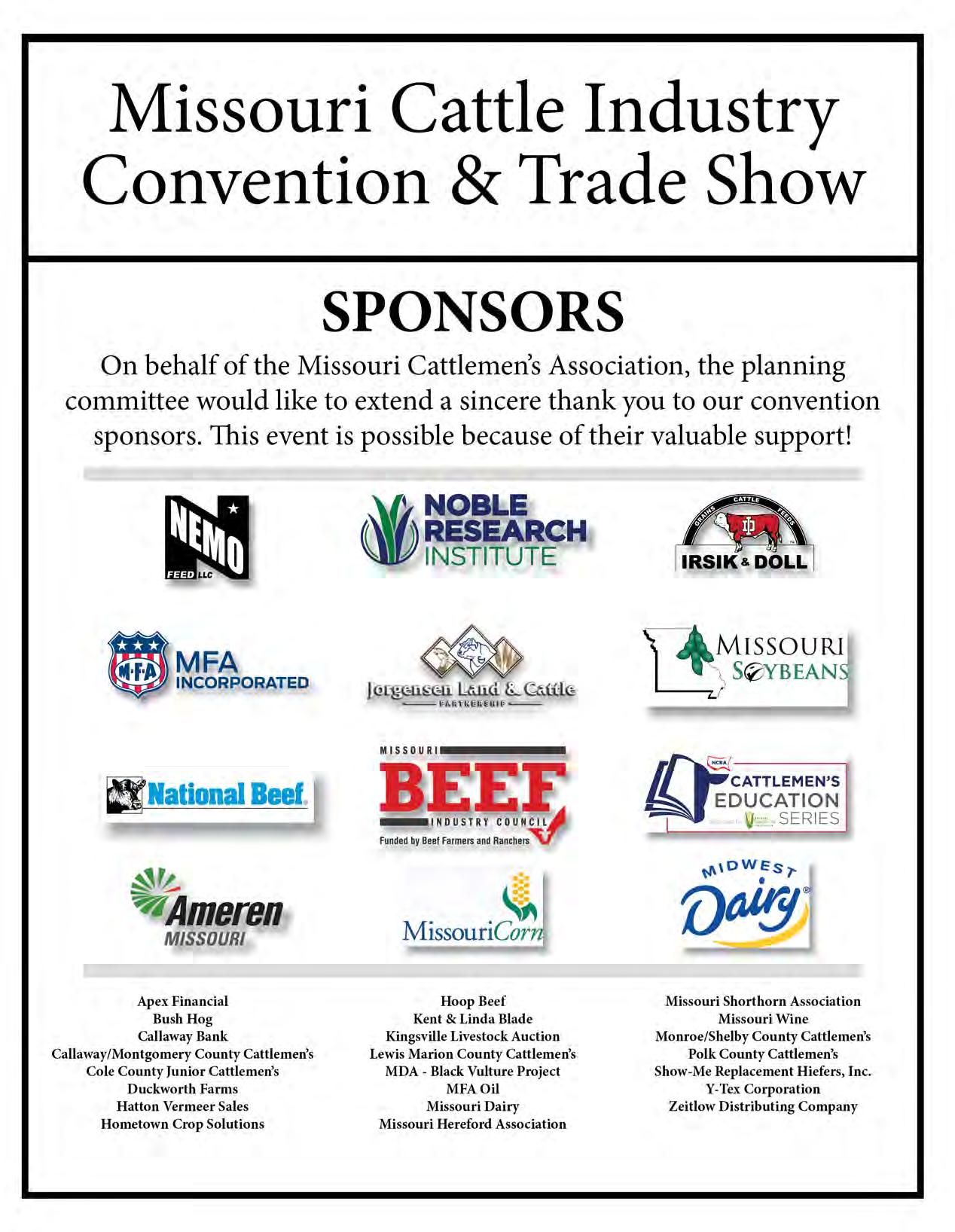




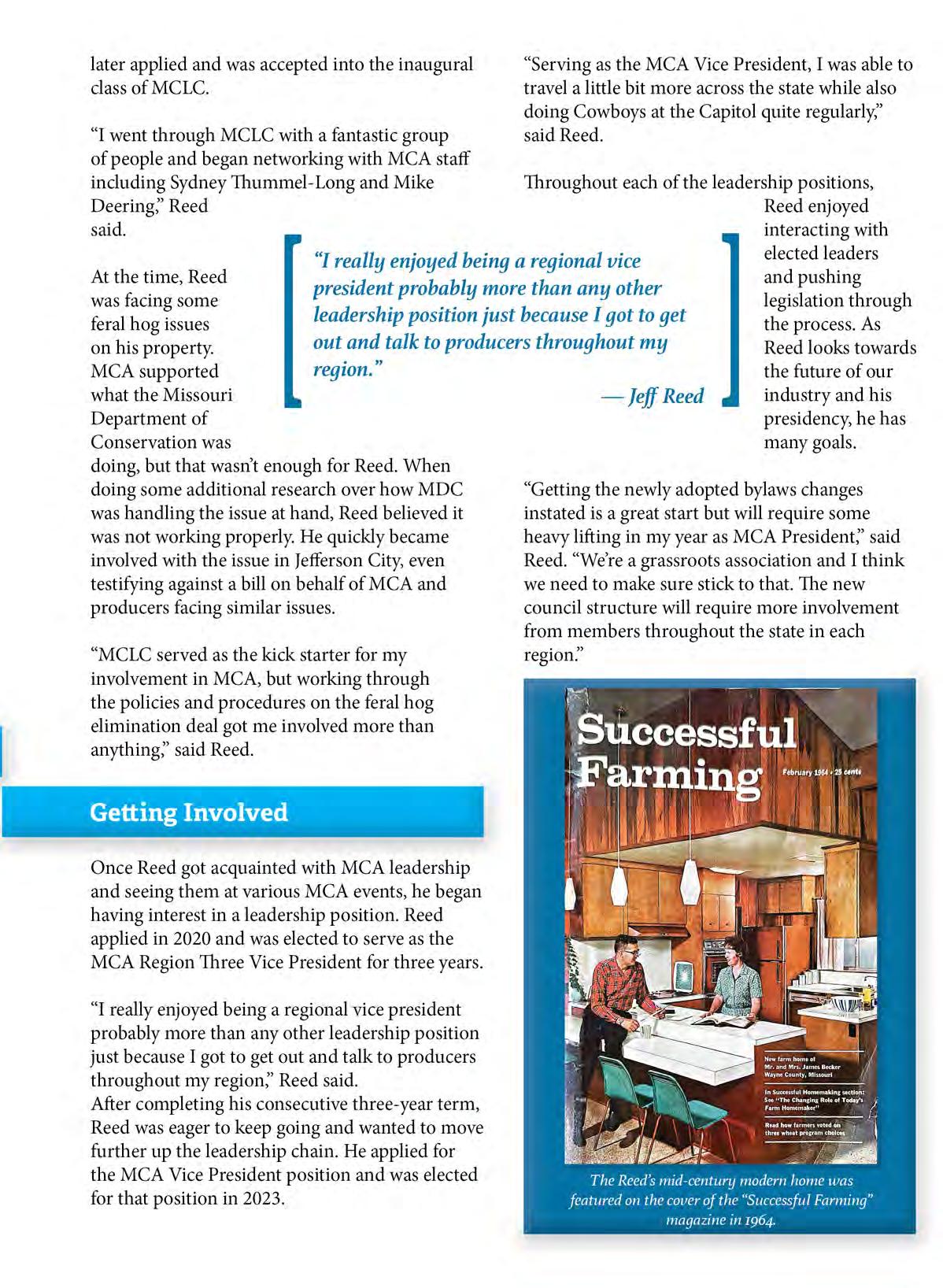
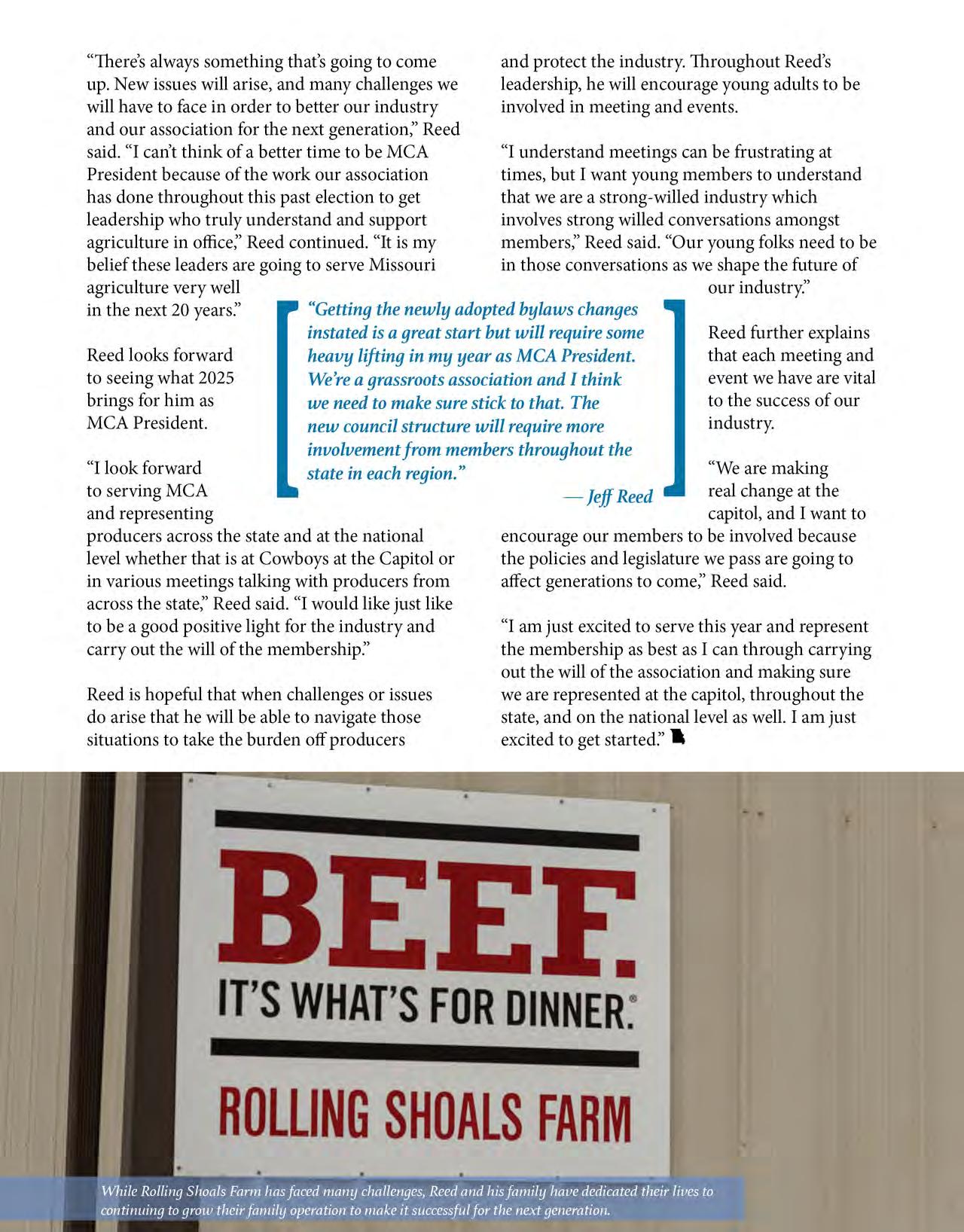
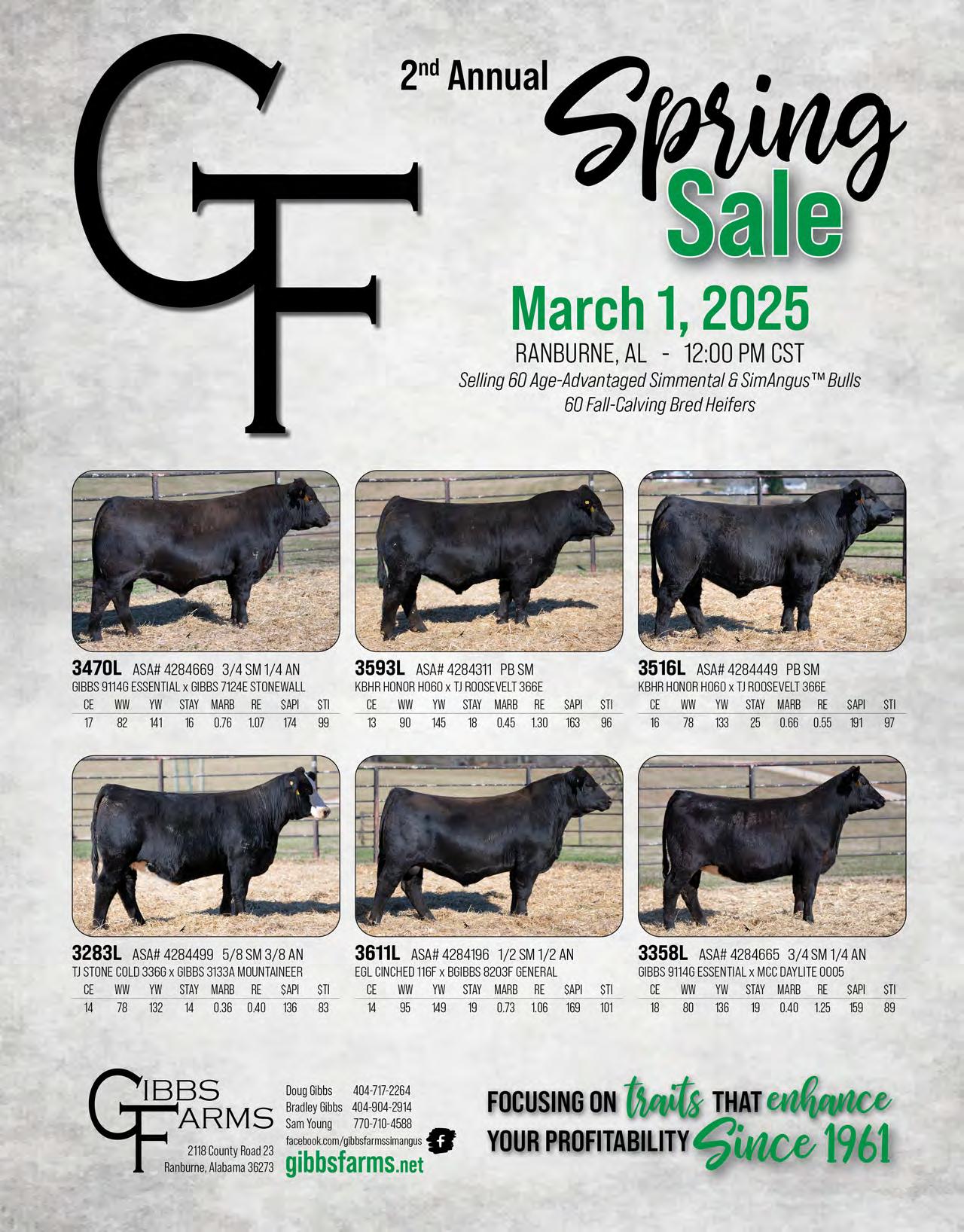


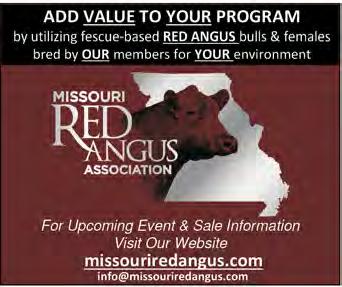

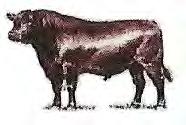
Ken & Brenda Keesaman
816-675-2503 • C: 816-390-4988
Kody Keesaman 816-724-1432
Kolten Keesaman 816-808-2846
3803 SW Rogers Rd. • Osborn, MO 64474
Ken@kkfarmsredangus.com www.kkfarmsredangus.com
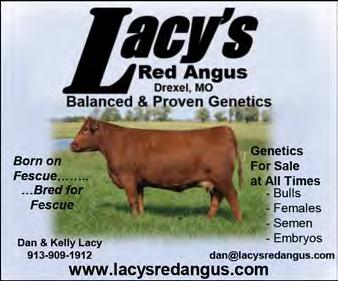
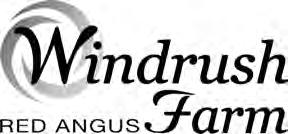



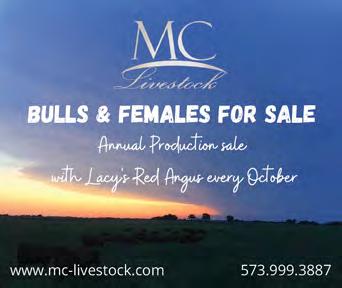
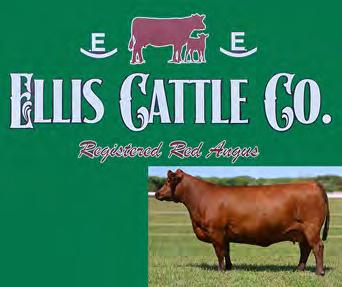



Lafayette County was well represented at 57th Annual Missouri Cattle Industry Convention & Trade Show held at Margaritaville in Osage Beach.
Trade Show participants included: Bart and Brenda Brackman, LAG Industries; Kris and Abby White, Corbin Steel Livestock Equipment; and Cody Tebbenkamp. Soil and Water Conservation.
Barbara Copenhaver is currently serving as Vice President of the Missouri Beef Industry Council and participated in their three day meeting. John Harris, Cow/Calf Council Chair, conducted the Friday morning council session. Marsha Corbin concluded her term as Missouri CattleWomen’s Association President. Other association members attended board meetings, trainings and workshops.
Kingsville, Missouri Hwy. 58 • 45 Miles SE of Kansas City, MO
Special Cow & Bull Sale Saturday, February 15 • 11:00 a.m.
Cattle Sale Every Tuesday 10:30 a.m.
For information call Rick, Jeremy, or Jared Anstine 816-597-3331
Visit our website kingsvillelivestock.com or E-mail us at: anstineauction@gmail.com
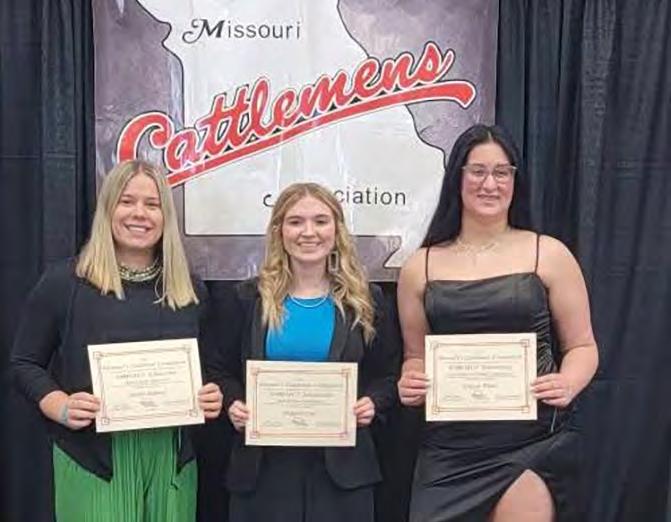
Three young women from Lafayette County were awarded scholarships. Annika Riekhof received the Kent Corbin memorial; Abigayle Lett received the Bob Richter Foundation award; and Abigail White received the Lewis/Marion County scholarship.
John Harris and Marsha Corbin were recognized at the Association Honors Reception for recruiting three to four new members Friday night. They both recieved a $25 certificate good for MCA merchandise or towards convention registration or auction items.
The educational meeting series continues at the Mayview Community Building on Tuesday, February 25 at 7 p.m. Hannah Copenhaver of Crop Insurance Solutions will present the program on Livestock Risk Insurance.
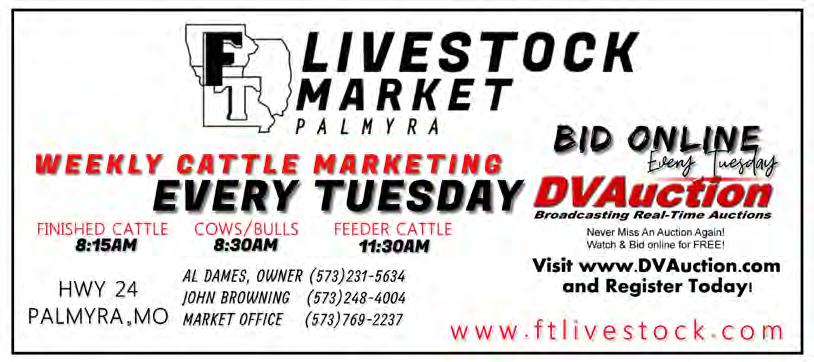
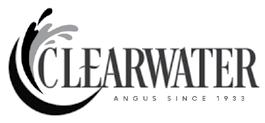

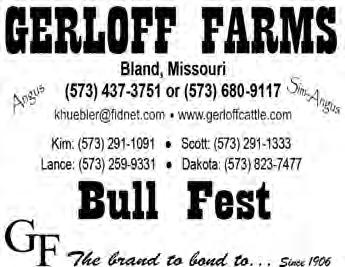

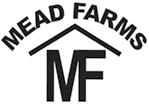
573-302-7011
Fax: 573-348-8325 E-mail: meadangus@yahoo.com
www.meadfarms.com



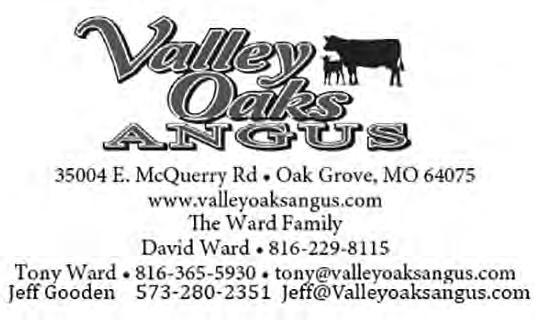
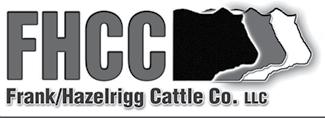






Last month, Mid-Missouri Cattlemen’s Association had a meeting with Boehringer Ingelheim. The meeting was held at Miller County Regional Stockyards in Eldon. We had a large attendance and enjoyed a dinner of roast beef, mashed potatoes, green beans, salad and dessert.
The main topic was the benefits of the market ready rrogram. Several of our local producers use this program to make sure their cattle are ready for marketing. The program guides the producers in vaccines, weaning, mineral supplements, etc. One of our local veterinarian spoke with the producers over the benefits of keeping their livestock vaccinated and wormed. Everyone joined in the conversation asking questions and providing discussions which is really helpful for the producers as they felt comfortable talking directly to their own vet.
Quality Liquid Feed was also the topic of conversation and the benefits of keeping it available to your cattle all through the year. QLF is 32% protein and is very rich in several of the nutrients that they require. If you have a lick tank, it allows the cattle to have several small


meals throughout the day. If a lick tank is not available, you can use a large round bale treatment. Simply pour the product on top of an upturned bale and it will soak through. This will significantly enhance the nutritional value of the hay.
We are very appreciative of Miller County Regional Stockyards as well as Boehringer Ingelheim for this educational meeting. It was a great opportunity and everyone enjoyed getting together.
Following the meeting we had a board meeting where Wendy Cantrell was re-elected as the President. Tanya Gardner was voted to stay on as the Secretary/Treasurer, and Ralph Kliethermes accepted to continue as Director.
President – Wendy Cantrell
Sec/Treas- Tanya Gardner Director – Ralph Kliethermes

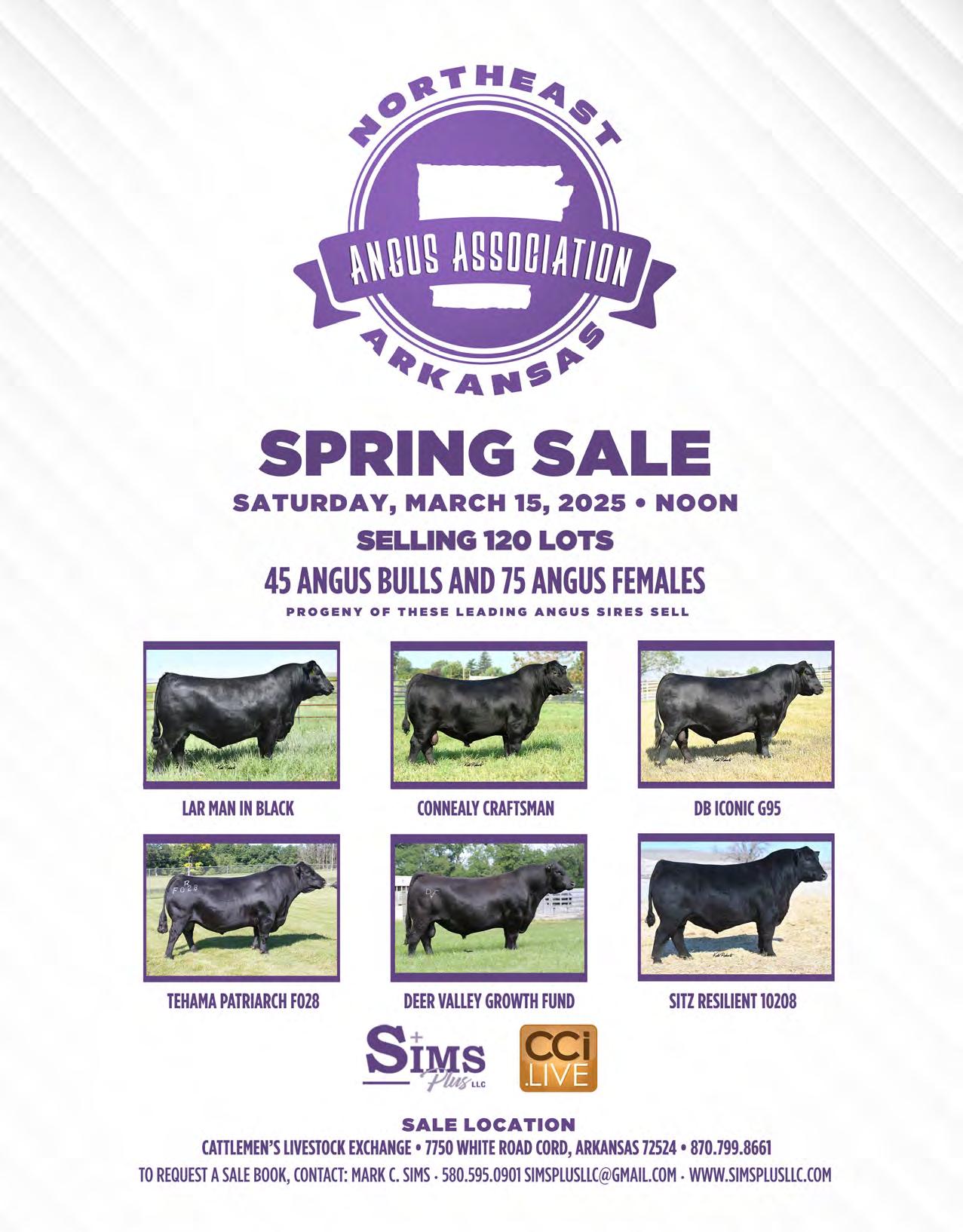
Wow! It’s hard to believe that two years have passed since Nathan Isakson took the podium for his first official meeting as the Southwest Missouri Cattlemen’s President. We have enjoyed his leadership, fellowship and true commitment to improving this association. His dedication has been impactful in many ways, and having said that it’s important to capture and record some valuable thoughts about his experience serving as president. The following are a few questions that came to my mind and his response:
What were your key goals when you took the helm?
Did you achieve them?
When I began my term as Southwest Missouri Cattlemen’s President, I wanted to be sure to maintain and increase participation in various affiliate activities to streamline the work of our officers and board of directors, and to provide relevant and practical speakers that would add value to the operations of our attendees. I truly believe our level of participation has maintained. I can still recall the way the room looked when we met in the administration building. Our group lost a few faces that weren’t able to return after the pandemic for one reason or another. In those days, we easily had 90+ people in the room. Over the past several years, 80-90 seems to be the high side of our running average!
Did you enjoy the experience?
I did! It was a tremendous honor and highlight to be able to serve the members of our association, and to represent them at the local and state level. It was a responsibility and level of trust I strived to not take lightly. Secondly, I wanted to be sure I was always approachable and accessible to our members, partners and state staff, while simultaneously making sure I never got ‘too big for my britches!
I am proud that our board of directors and affiliate created several new initiatives over the past two years including the SWMCA Top Hand Award; the Jim McCann NCBA SWMCA Member Stipend; SWMCA Standard Operating Procedures; and several needed updates to our bylaws to allow them to reflect the progress that was made prior to my term of office.
I thought it was a great and challenging experience and a unique way to grow both professionally and personally. I felt a tremendous responsibility to be diligent in continuing the foundation of success my predecessors were responsible for while finding ways to thoughtfully add to our association. At the end of the day, I loved the opportunity to connect with our members at meetings, cattle sales, fall tours, and Apple Butter Makin’ Days.
You know how it is - there’s just something about being connected with people who value being engaged!
Serving as president led to many new friendships, connections and opportunities. It truly was as rewarding as it was challenging. There’s not a better group of people to be around than cattlemen! Thank you for the opportunity to serve!
I think we all agree with how Greg Lenz characterizes Nathan as a “no-nonsense leader who is well equipped in his knowledge of the cattle industry and livestock in general. His magnetic personality helps to bridge the gap between young and old, new technology and tried and trusted philosophy. It will be interesting to watch Nathan as he achieves state and national leadership roles in the future.”
We sincerely thank you Mr. Isaakson for your leadership, growth and improvement of the SWMOCA.
Our new SWMOCA President, David Sperandio, took the helm for his first official meeting. We are looking forward to his leadership. We are confident he’s going to do a topnotch job! On the farm, David raises a commercial cattle herd, butcher hogs, and various crops including alfalfa, clover and corn. Off the farm he’s been an associate of MFA for over 30 years. He serves on the Missouri Cattlemen’s Association Board, as delegate for the MFA Oil & MFA Inc. He is also a longtime member of the SWMCA Grill Team, and as Nathan Isaakson says, “if the grills are fired up, you can bet that he’s there!”
At the first meeting of the new year, we were blessed to welcome our newest member of the SWMO Cattlemen’s family, Ella Ulrich. Ella has a big sister, Eva, and is the daughter of Jordan and Betsy Ulrich. Our members have been praying for Ella along with all the little ones at the Ronald McDonald House to heal and gain the strength to return home. We were especially thrilled to have them attend our January meeting.
Boehringer-Ingelheim representative Randy Schilling, sponsored our meeting and spoke about the four pillars of sustainability. The primary focus was on the implementation of combination treatments for parasites, reminding us of the importance of using dewormers from two different drug classes. Mr. Schilling presented information on the BoehringerIngelheim products available to implement combination treatments, answered questions, and was available after the meeting to speak with members one-on-one.
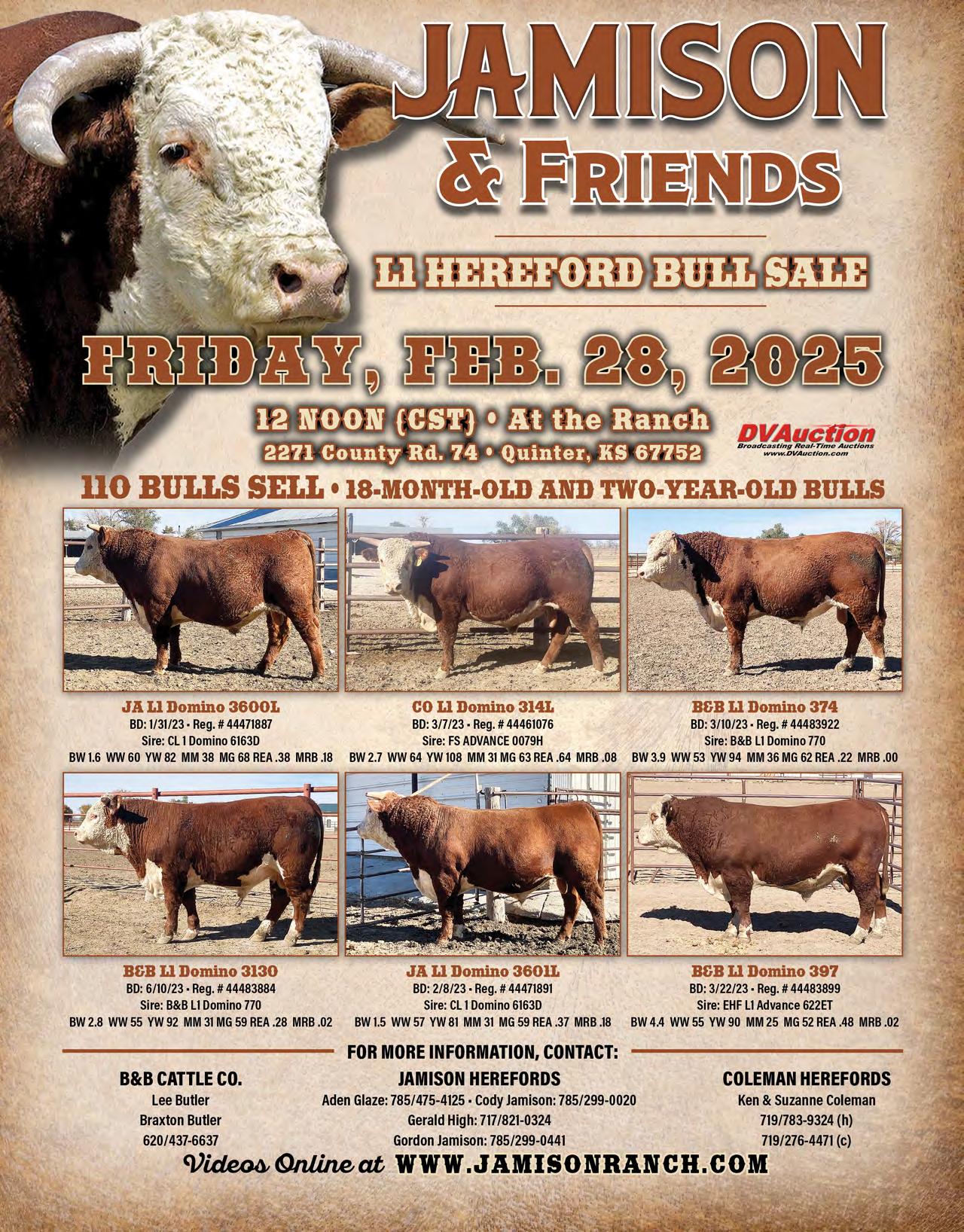
Raymond “Buster” Lee Kueckelhan, age 92, of Boonville, passed away on Friday, December 20, 2024, at the University of Missouri Hospital. He was born in Boonville, Missouri, on August 8, 1932, the son of Robert and Ruth (White) Kueckelhan.
Buster graduated from Boonville High School and was drafted into the United States Army, serving his country in the Korean War as a mechanic. He married the love of his life, Roberta “Birdie” Gerhardt on June 19, 1960, in Billingsville.
He was a farmer for all his life beginning with raising hogs in a junkyard as a boy and raising strawberries. He also worked in his father’s business, Kueckelhan’s Garage and then Custom Trucking and Combining.
He was a member of the St. Johns United Church of Christ Church. He didn’t have many hobbies, besides spending time with his cows and working! He worked up until the day he passed away.
Buster is survived by his wife Birdie Kueckelhan of the home; children: Teresa (Paul) Carlson of Mexico, Tim (Julie) Kueckelhan of Boonville, Angie (Jason) Hackman
of Boonville; grandchildren: Morgan (Chris) Hawley, Kaitie Cauthorn-Thomas, Jared Kueckelhan, Andrew (Clarissa) Cauthorn, Justin (MaKenzie) Kueckelhan, Will Hackman. Great-grandchildren: J.R. Cauthorn, Jace Hawley, Emmett Cauthorn, Steele Hawley, Carter Sue Cauthorn; and several nieces and nephews, and other family members.
He was preceded in death by his parents; siblings: Katherine Alexander, Cammie Kueckelhan, Robert Kueckelhan, Phillip Kueckelhan, Roger R. Kueckelhan, Joan Booker.
Due to unforeseen circumstances, the memorial service for Raymond “Buster” Kueckelhan has been postponed. Additional information will be forthcoming.
Memorials in his honor may be made to St. John’s United Church of Christ.
Arrangements are under the direction of Howard Funeral Home, 1397 Ashley Rd., Boonville, Mo 65233 (660) 882-3381. Condolences can be made to the family at www.howardfh.com.
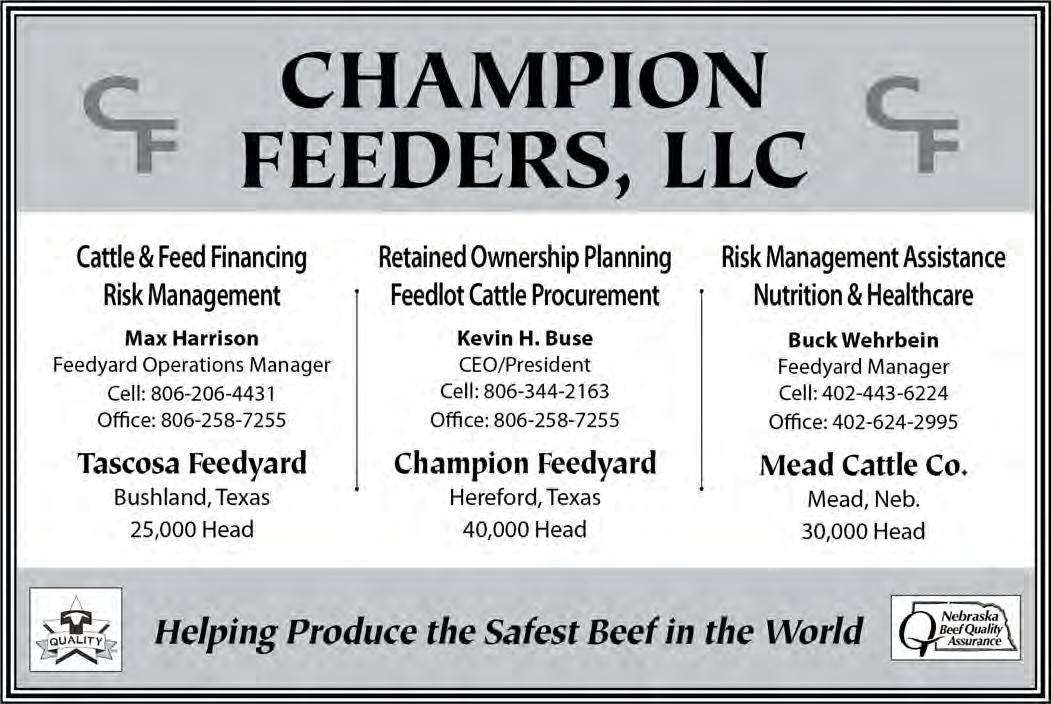
Jacob Norval Rapp was born at Cedar County Memorial Hospital in El Dorado Springs, Missouri to Myron and Kathy (Norval) Rapp on July 18, 1996. He attended kindergarten at Rich Hill and elementary school at Zion Lutheran where he was the only graduate of his 8th grade class. He attended high school and graduated from Rich Hill in 2015. After completing high school, Jacob attended college at Crowder College and transferred to Missouri State University. There, he graduated with a bachelor’s degree in plant science and a minor in animal science in 2019. After college, he married the love of his life, Allison Steuck, on March 21, 2020. They welcomed their daughter, Lillie, in July 2024.
Jacob was a life long member of Zion Lutheran Church in Prairie City. He was received into the family of God through baptism on August 4, 1996, and confirmed his faith on April 17, 2011. He was active in church, attending Sunday school, youth group, and was an usher.
Jacob loved growing up on the farm in the Prairie City area working with his dad and brother, Levi. He took joy in taking care of the animals, especially the cattle. After college, he returned home to work on the family farm raising row crops and cattle. He started his own herd of red angus cattle working closely with his grandpa Norval. He enjoyed all things outdoors but formed an avid love for hunting and shooting sports. He excelled at hunting and long range shooting and had many successful hunts with family, friends, and his favorite hunting dog Grizz.
Jacob always knew what he wanted from an early age. In kindergarten, he met Alli and knew right away he wanted to marry her. In 2014, they began dating. It wasn’t long after in 2018, he proposed to Alli. In March, 2020 at the Rich Hill Christian Church he married his high school sweetheart. They worked together on the family farm with their dog, Grizz, and cat, Milo. Jacob and Alli enjoyed doing many things together, especially traveling. Some of their adventures included going to Alaska, Alabama, California, Colorado and Utah. But their greatest adventure was the birth of their daughter, Lillie. Being a father was his greatest fulfillment. Jacob never met a stranger and was a friend to all. He loved hosting and attending gatherings with friends.
In April 2024, Jacob was diagnosed with cancer. He remained faithful to God through his hard-fought battle. He was called home to heaven on January 6, 2025, at University of Kansas Medical Center. He is preceded in death by his grandfather, Eldo Rapp, and aunt, Pam Shumaker. He is survived by his wife, Allison and daughter, Lillie, of the home; parents Myron and Kathy Rapp, brother, Levi (Rachel) Rapp; grandmother, Frieda Rapp; grandparents, Joe and Doris Norval; father and mother-in-law, Jeff and Kori Steuck; sisterin-law, Kyra (Zane) Lowrance, nieces Thea and Thalia Lowrance; brother-in-law, Gavin (Tiffany) Steuck; and numerous other family and friends. Those whom he left behind will cherish their memories and miss him greatly.

The American Royal celebrated its 125th anniversary in 2024 and added a Spring Youth Livestock Show. With the American Royal being deeply committed to inspiring and developing talent for food and agriculture, we are excited to bring this back in 2025. Don’t miss this amazing opportunity where youth exhibitors are celebrated, and champions are crowned.
Thursday, March 27
8 a.m. Move-In, All Species
10 p.m. Gates Close
Friday, March 28
8 a.m. Gates Open, Continue Move-In
1 p.m. Sheep & Goats In Place, Weight Cards Due, Showmanship Sign-Up Due
2 p.m. Easter Egg Hunt
4 p.m. Sheep Showmanship – Senior, Intermediate, Junior, Peewee
5 p.m. Goat Showmanship – Senior, Intermediate, Junior, Peewee
6 p.m. Steers In Place, Weight Cards Due, Showmanship Sign-Up Due
Saturday, March 29
8 a.m. Move-in, Hogs (all hogs must be on the g rounds by 1:00 p.m.)
9 a.m. Sheep Show – Wether Dams, Prospect, Market – Hale Arena
10 a.m. Goat Show – Wether Dams, Prospect, Market – Hale Arena
12 p.m. Steer/Steer Momma Show – Prospect, Market, Steer Momma – Hale Arena
1 p.m. Heifers In Place, Check In, Showmanship Sign Up Due
1 p.m. Hogs In Place, Weight Cards Due, Showmanship Sign Up Due
1 p.m. L ivestock Judging Clinic Registration
2 p.m. L ivestock Judging Clinic
Sunday, March 30
8 a.m. Swine Show – Governors/Scott Pavilion Ring A – Showmanship, followed by Breeding Gilt Show Ring B – Prospect followed by Market Hog Show
8 a.m. Cattle Showmanship (Steer/Heifer) –Hale Arena
Followed by: Purebred Heifer Show, Commercial Heifer Show
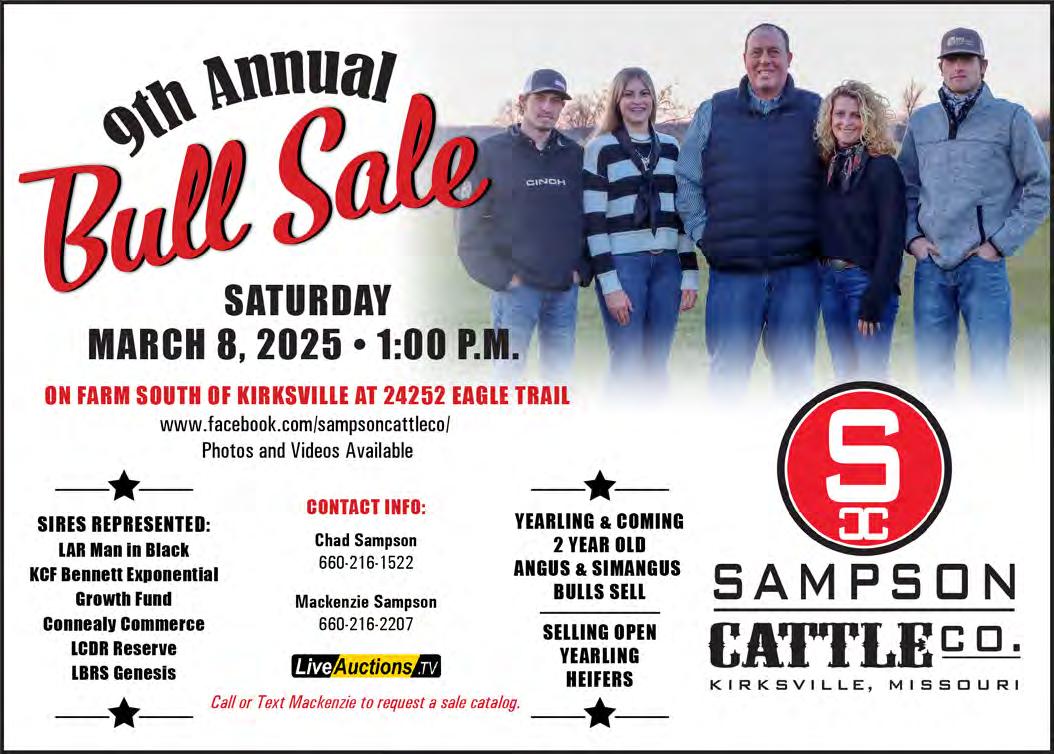
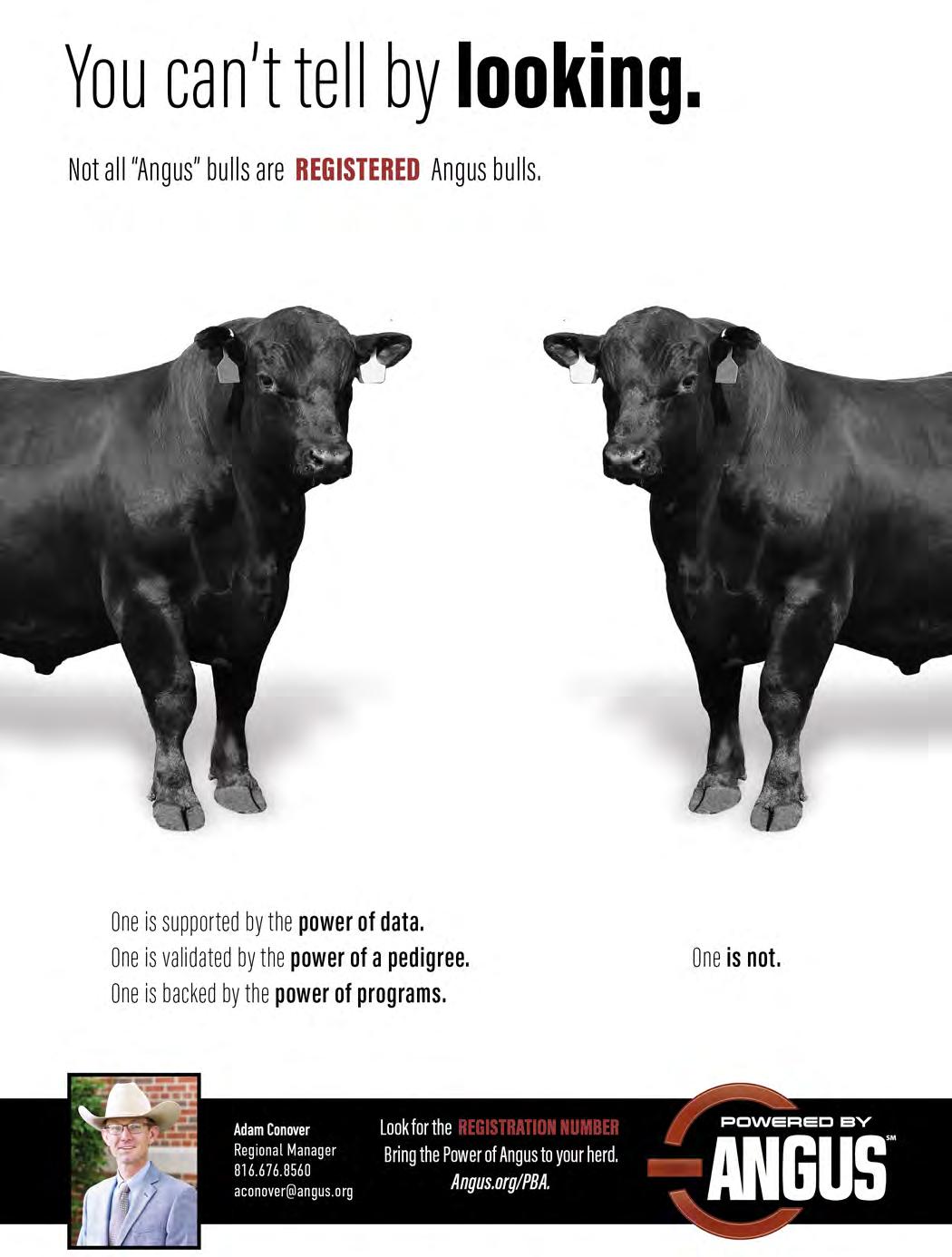
Source: American-International Charolais Association
Kansas City, MO – The American-International Junior Charolais Association, has recently released the debut of the Phenotype and Genotype Show to be held at the 2025 AIJCA Junior National Show. This new competition integrates traditional cattle evaluation with modern genomic selection technology, offering junior members an unparalleled opportunity to expand their knowledge and skills in cattle breeding and selection.
The P&G Show will be held in conjunction with “The Greatest Show,” the 2025 AIJCA Junior National Show & Leadership Conference, scheduled for June 16-21, 2025, in Springfield, Missouri.
“The P&G Show will reward real-world, structurally correct, industry-relevant cattle developed by our junior membership,” said Brett Spader, AICA Executive Vice President. “This new opportunity empowers junior members to identify and develop females that can advance their breeding programs and contribute to the industry with functionality, longevity, and genetic improvement.”
The P&G Show will feature a composite scoring system, with 50% weight on genotype and 50% on phenotype, ensuring a comprehensive evaluation of each animal. Here’s how it will work:
• Genotype Evaluation: Prior to the show, judges will receive cards detailing each entry’s birth date, genomically enhanced Expected Progeny Differences, and breed percentile rankings. These metrics will form the basis of the genotype score.
• Phenotype Evaluation: During the Junior National event, the same judges will assess the animals’ physical attributes, including structural correctness and industry relevance, to determine the phenotype score.
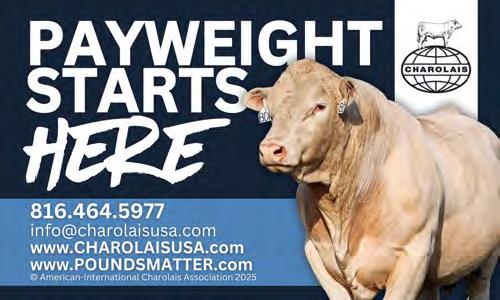
• Final Rankings: The combined scores from the genotype and phenotype evaluations will determine class placings. In the event of a tie, preference will be given to the phenotype score.
Classes will be divided into divisions based on age and class size, as determined by the show classification committee.
To participate in the inaugural 2025 P&G Show, entries must meet the following criteria:
• Purebred Heifers Only: Eligible animals must be purebred Charolais heifers.
• DNA on File: DNA sample results must be submitted and on file with AICA by March 1, 2025.
• GE-EPDs Published: Genomically enhanced EPDs must be published in the April 2025 National Cattle Evaluation.
• Age Requirement: Eligible heifers must have been born on or after September 1, 2023.
• Ownership Deadline: Juniors must have full interest and possession of the cattle by May 10, 2025.
• Non-Fit Competition: The P&G Show will follow a non-fit format.
The P&G Show will offer significant cash awards, including Grand Champion and Reserve Grand Champion prizes. Additionally, 70% of entry fees will be distributed as class premiums, proportional to the number of entries per class.
“The Phenotype and Genotype Show represents an exciting new direction for our junior members,” said Kaitlyn Chism, AICA Director of Youth Activities and Foundation. “By combining visual evaluation with genomic data, we’re equipping our youth with the tools they need to succeed in the evolving cattle industry. This show encourages critical thinking about both the physical and genetic attributes of their animals, fostering a deeper understanding of cattle breeding.”
In addition to the competition, the AIJCA will host an educational event during the Junior National to provide insights into cattle evaluation, share show results, and celebrate the contributions of Charolais genetics to the beef value chain.
For more information about the 2025 Phenotype and Genotype Show and entry details, contact Kaitlyn Chism at kchism@charolaisusa.com.
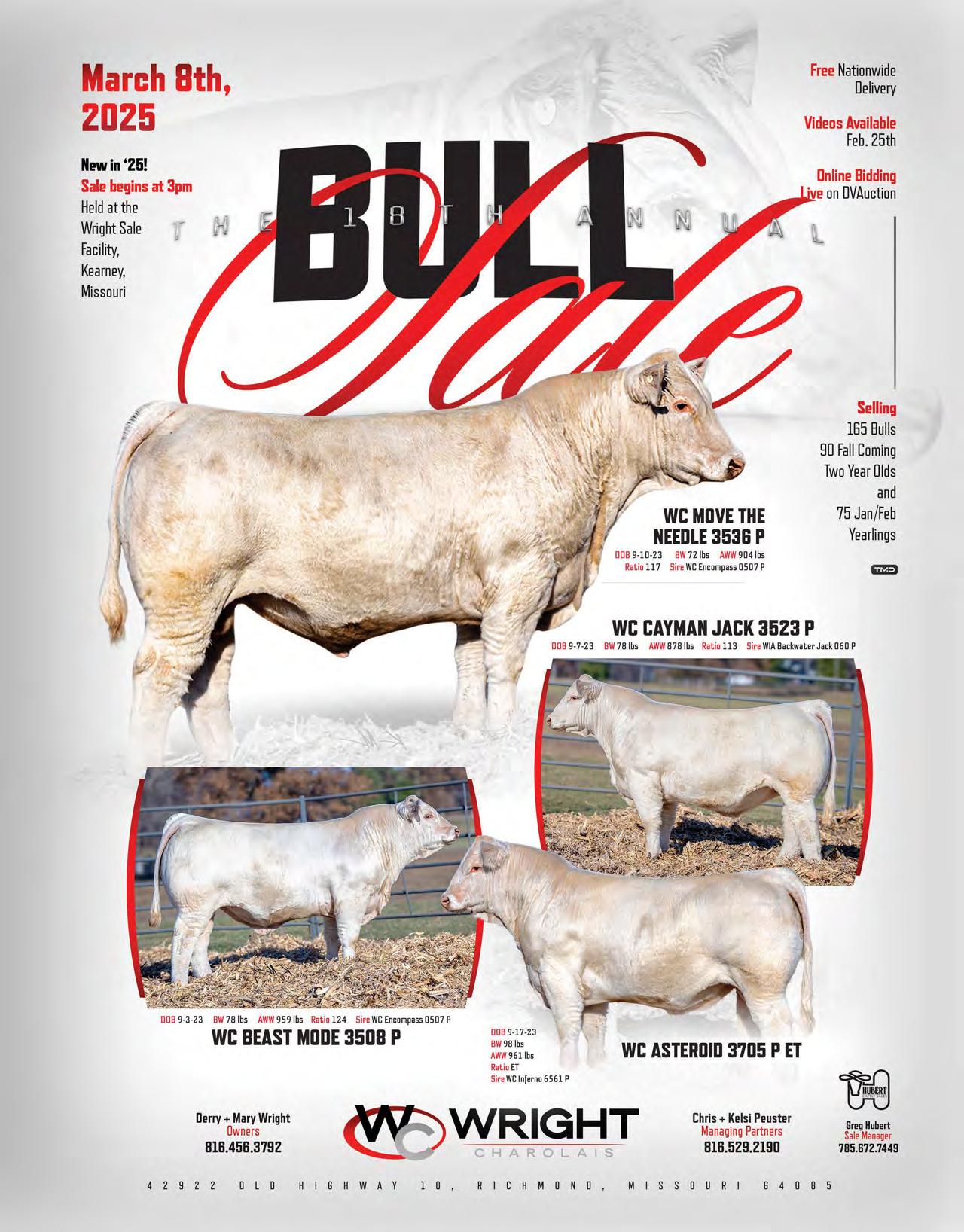

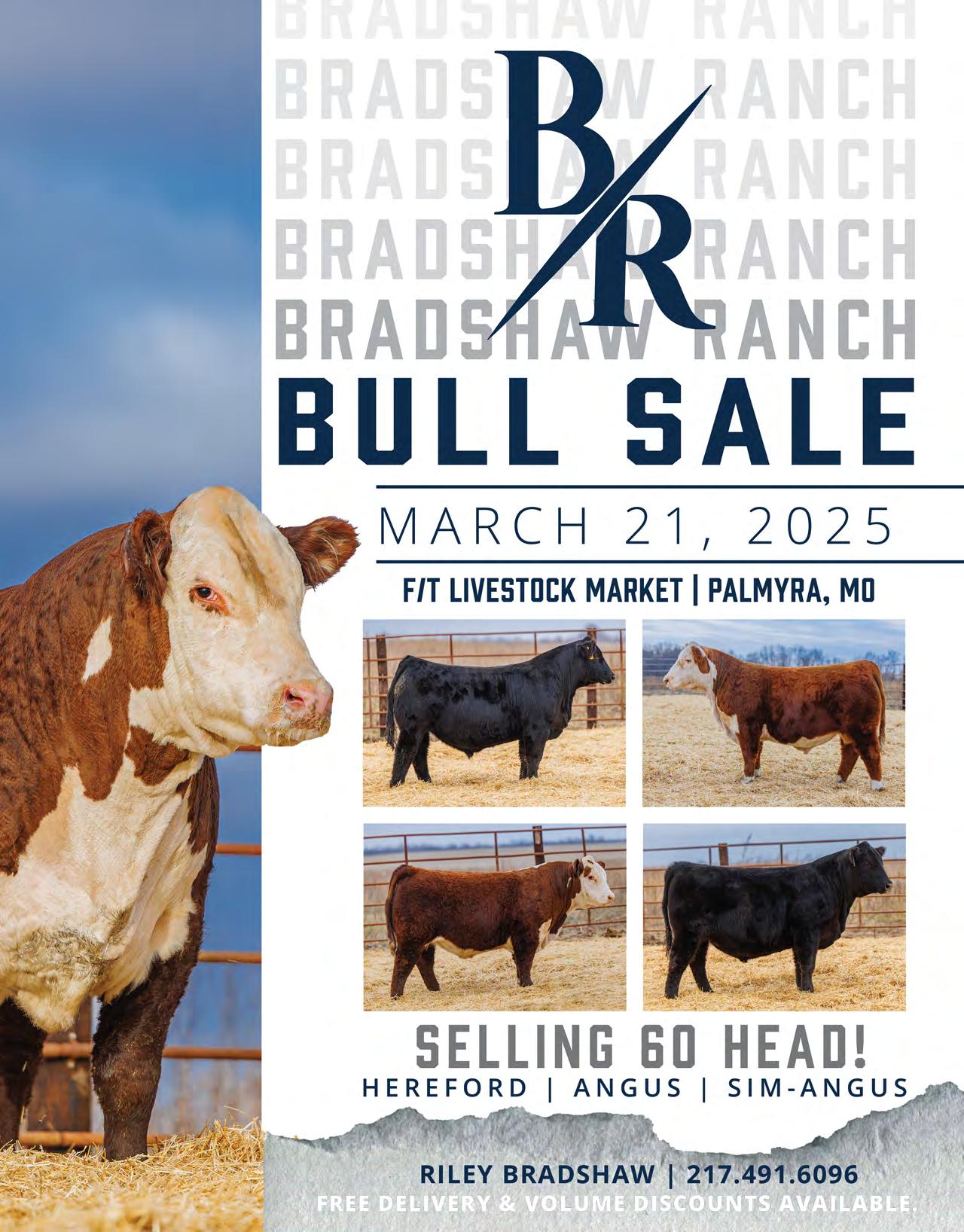
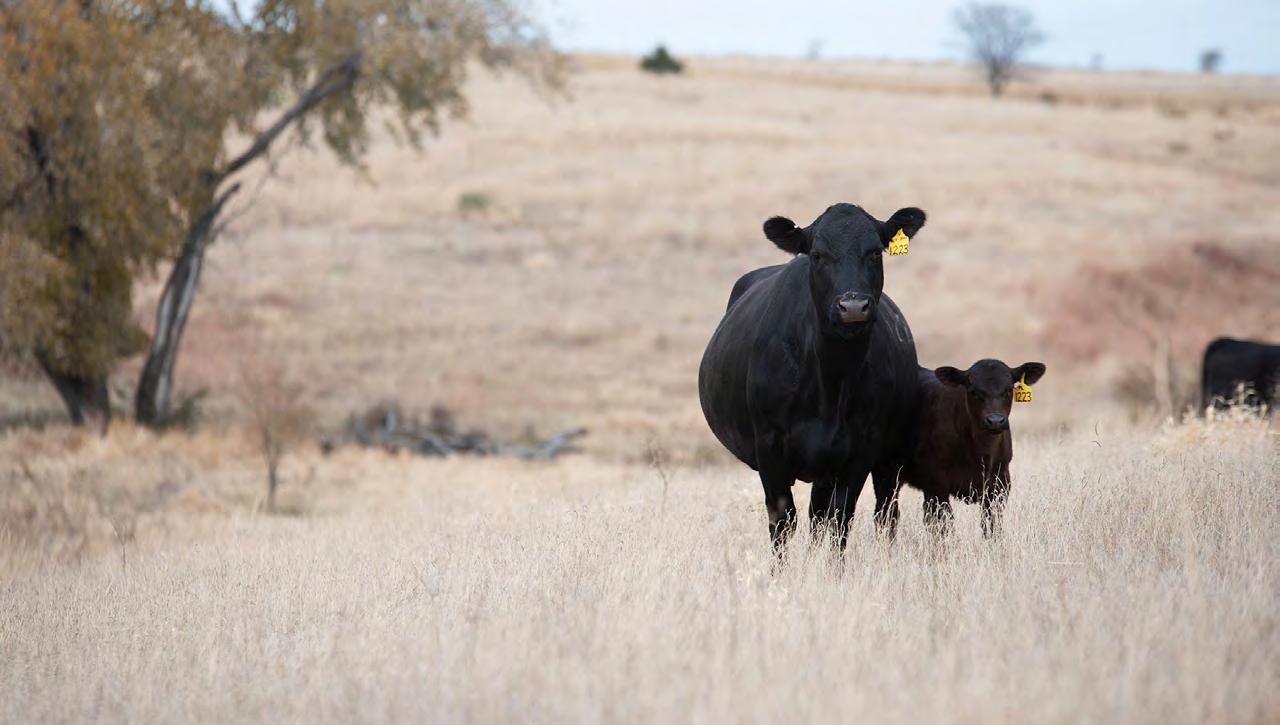
Source: Tom Strahm, American Gelbvieh Association
John Fox, along with his partner Kim, operates Fox Farms in Cedar County, Missouri, on land whose roots run deep. The homesteaded ground, that has been expanded over the years, is home to Fox’s cow-calf and backgrounding operation.
I got a chance to sit down with John to learn more about his operation and the goals he has for his herd. The answer is easy to summarize “To produce better cattle every year.”
In the interview below, John shares his insights into his operation, his journey with different breeds, the importance of genetics and what led him home to the Gelbvieh and Balancer™ breed.

Tom: John, tell us about your family’s history in cattle breeding and how you came to use Gelbvieh and Balancer genetics?
John: Our journey began with my father using Angus cattle. We then transitioned to Charolais crosses to improve growth and color uniformity. We noticed a decline in milk production, which led us to look at other breeds. We started using red Gelbvieh bulls on our Charolais cross cows through seedstock plus. This brought back the milk production we needed. When the demand for black cattle increased, we switched to black Balancers. Since then, we’ve been consistently improving our herd by selecting better bulls with each purchase.
Tom: What improvements have you seen in your herd since beginning to use Gelbvieh and Balancer bulls?
John: We’ve seen a lot of improvement in our herd, especially in milk production. We focus on bulls with a with a higher percentage of Gelbvieh to maintain milk production for raising a calf. It has really helped up to sell replacement heifers, a lot of times at a good premium. The feedback we get helps us to know that we’re moving in the right direction.
Tom: You mentioned that your current set of first-calf heifers might be the best you’ve ever raised. What makes them stand out?
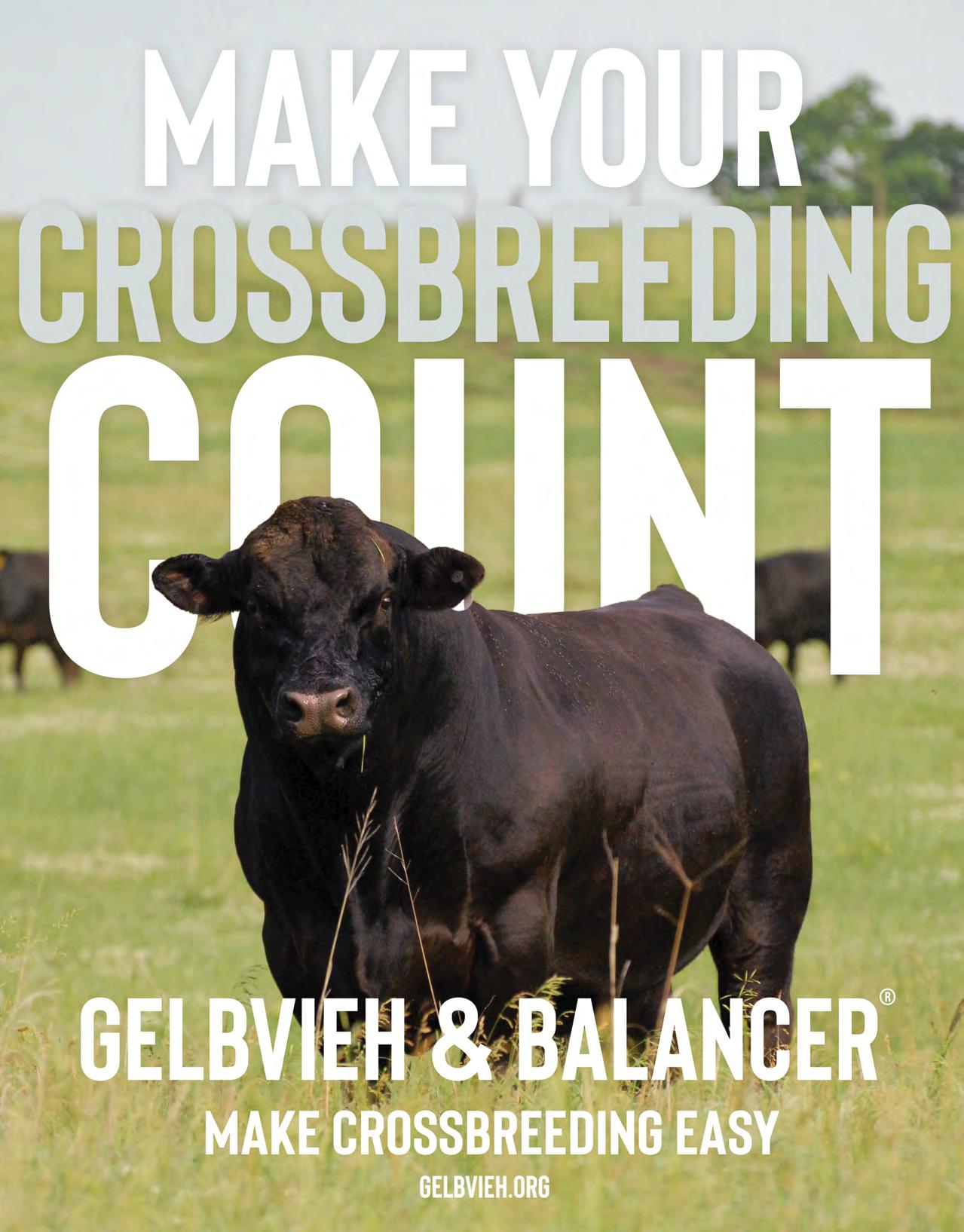
John: These heifers have been exceptional in several ways. They started calving around September 10, and we’ve been impressed with their condition, disposition and milk production. They’re maintaining their condition well even with calves at their side. My wife works a full-time job and a lot of the time I’m here by myself. I’ve been able to handle these heifers by myself and that makes a big difference.
Tom: Has the fertility of Gelbvieh and Balancer influenced cows and heifers lived up to your expectations?
John: The fertility rate has been very good. We have a good mineral program too. Our cows have been breeding back in the 90 percentiles for the past several years. The milk is also really good. It just keeps increasing. Those two things are really where I feel like the breed has benefitted us. We are going in the right direction with a Gelbvieh-cross.
Tom: How important are relationships in your operation, particularly when it comes to buying bulls?
John: Having a good relationship with the people you work and do business with is important. Whether it’s your veterinarian or the breeder, you can always gain information that helps you to provide a better product. That’s what we work to do here. Maintaining good relationships fits into the combination of using all of your resources to make a better product.
We’ve got a good reputation and have buyers who want to know when we are going to sell our feeder calves. To me, it’s a sign that we are going in the right direction. You know, even in times when there were so many cattle

moving and the sale numbers were higher, we still had that demand for our cattle because the buyers knew how they would perform.
Tom: What do you look for when selecting bulls for your operation?
John: I look at the bull. I want to see what kind of cover he has, his shape – how he’s made. Beyond that, I focus on several things. Calving ease is important, and I look for milk production of 20 plus. I also consider docility and overall conformation. While I pay attention to daily gain, it’s not my top priority because it can vary with age.
Continued on page 66

Dedicated to continuing the positive traits of disposition, calving ease, milk, and growth since 1978. Polled, Purebred and Fullblood Red Bulls for Sale • Available Late Fall Select Group of Red Females • Some Pairs Barb, Butch & Heather 317 State Rd B
MO 417-345-6396 or 417-872-6414 65722
1 mile west on Hwy 32 • Buffalo, MO 65622 Barn: 417-345-8122
Sale Every Saturday 12:00 Noon
• Selling 1200 to 1700 head Farm Fresh Cattle weekly
• Special Stock Cow and Bull Sale 3rd Tuesday night of each month at 6:30 p.m.
• Pre-Vac Feeder Calf Sales 2nd Saturday of every month in conjunction with Regular Sale (Pfizer Pre-Vac, BLM BPre-Vac, Bayer Program, Mo Quality Assurance. LMA-Vac and MFA Health Track)
Order Buying Service Available Owners… Lyle Caselman Leon Caselman 417-345-7876 H 417-345-4514 H 417-533-2944 cell 417-588-6185 cell

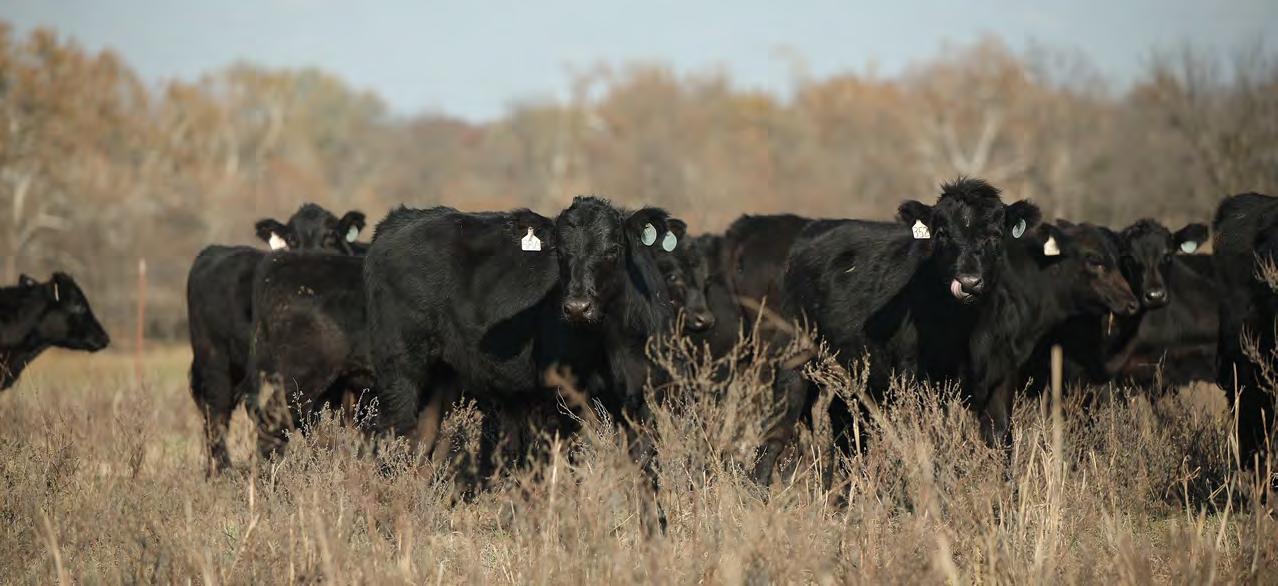
Tom: Do you feel like the Gelbvieh bulls you purchase last? How is the return on investment?
John: We invest a lot in our bulls, so we expect them to last at least four or five years, compared to what we see the industry average of one or two years. We purchase insurance because of the substantial investment we’ve made but we rarely have to use it. Our bulls have performed well over the duration which I see as another positive aspect of the breed. The longevity of a Gelbvieh bull adds a lot of value to our operation.

Tom: What are your thoughts on bull purchases?
John: I think people need to up their ante on bull purchases. We shouldn’t just be looking at producing a calf, we should be looking at producing a quality calf and a good bull helps you get there.
Tom: What advice would you give to others in the livestock industry?
John: My main advice is to focus on producing quality calves, not just quantity. It’s important to invest in good genetics by purchasing quality bulls from reputable breeders who can guide you in the right direction. While it may seem expensive initially, it pays off in the long run. Consider how many calves a bull produces over its lifetime and the impact of keeping his daughters in your herd. Good genetics, combined with proper management and stockmanship, is a key to being successful in this industry.

have ever done is sell and trade trailers. Give me a call for your next trailer 800-897-9840 www.Jimsmotors.com Commodity Trades Welcome
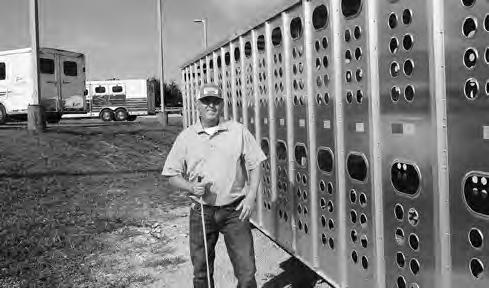
• All Bulls Semen & Trich Tested
• EPDs & Ultrasound Data
• Blacks & Reds
• Several DNA tested Homozygous Black/Homozygous Polled
• Low Birth Weights/High Growth/ Packed with Meat & Muscle
Select Group of Open Purebred Gelbvieh & Balancer Heifers
• All Heifers will be Pelvic Measured & Reproductive Scored Bred Heifers & Cow/Calf Pairs

Selling Tremendous Set of Open Heifers Like These
Source: American Gelbvieh Association
LINCOLN, Neb. – Members of the American Gelbvieh Association elected five candidates to the board of directors at the annual membership meeting held December 6, 2024, during the AGA National Convention in Kansas City, Missouri.
Newly elected board members are as follows: Mark Stock, Iowa; Stuart Jarvis, Kansas; and John Shearer, Kansas. Re-elected to serve a second term were Zach Butler of Tennessee and Gregg Hartman of Colorado.
The AGA board of directors also elected individuals to serve in leadership positions on the executive committee for 2025. Dan Warner, Nebraska, was elected president. Stuart Jarvis, Kansas, was elected vice president. Brent Overmiller, Kansas, was re-elected secretary. Tom Vehige, Missouri was elected treasurer.

The American Gelbvieh Association elected directors and officers for 2025 during its national convention in Kansas City, Mo. Back row (left to right): Greg Hartman, CO, Mark Stock, IA, John Shearer, KS, Troy Forbes, SD, William McIntosh, KY; Middle row (left to right): Greg Anderson, NC, David Larson, MN, Zach Butler, TN, Justin Taubenheim, NE, Mark Covington, CO; Front row (left to right): Dan Warner, NE, Stuart Jarvis, KS, Brent Overmiller, KS, Tom Vehige, MO, Harold Bertz, MO. Not Pictured: Cory Voss, NE.
Other members of the board include David Larson, MN, William McIntosh, KY, Troy Forbes, SD, Justin Taubenheim, NE, Mark Covington, CO, Greg Anderson, NC, and Cory Voss, NE.
Retiring members of the 2024 AGA board of directors were Lori Maude, South Dakota, Gary Felger, Missouri, and Todd Bickett, Georgia.


The American Gelbvieh Association is a progressive beef cattle breed association representing 1,000 members and approximately 40,000 cows assessed annually in a performance-oriented total herd reporting system.
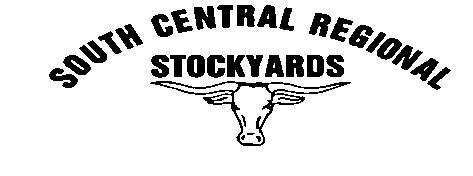

Source: University of Missouri Extension
COLUMBIA, Mo. – Missouri’s economy surged ahead in the third quarter of 2024. The state’s gross domestic product grew at an annualized rate of 3.8%, outpacing the United States average of 3.1% and ranking 16th nationwide for economic growth during the quarter.
Key sectors driving this expansion included retail trade, health care and professional and technical services, said Alan Spell, University of Missouri assistant extension professor of applied social sciences. By late 2024, Missouri’s economy reached $455 billion, securing its place as the 22nd-largest in the nation.
Retail and health care lead the way Retail trade was a standout performer, accounting for 33% of Missouri’s growth rate over the past year.
“Although slightly below the U.S. share of 35%, this sector remains a powerhouse for the state’s economy,” Spell said.
Meanwhile, health care and professional and technical services punched above their weight, contributing 13% to Missouri’s growth, surpassing the national contributions of 11% and 9.4%, respectively. However, not all sectors contributed positively: Education services reduced GDP by 1.6%, and administrative services shaved off another 2.6%.
Urban vs. rural economies: A mixed picture
While the U.S. Bureau of Economic Analysis provides quarterly state GDP estimates, Spell said, more detailed annual county-level data and industry figures for 2023 revealed how economic growth varied across Missouri’s urban and rural areas:
• Urban areas, represented by metropolitan counties, grew 2.6% in 2023, closely mirroring the U.S. metro growth rate of 2.7%. Arts, lodging and food service

industries grew by 3.6%, exceeding the national rate of 3.1%. The health care sector grew by 6.5%, outperforming the national rate of 5.3%.
• Rural areas, represented by nonmetropolitan counties, expanded by 2.8%, exceeding Missouri’s metro growth but falling short of the 5.2% U.S. nonmetro average. The tourism-related arts, lodging and food services sector increased 5.7%, more than doubling the national rate of 2.4%. The health care industry grew 6.1%, higher than the national average of 3.5%.
“Sectors like retail trade drove gains in both urban and rural areas, growing by 12% statewide—more than one percentage point higher than the national average,” Spell said.
Missouri’s agriculture sector saw significant rural gains, with nonmetro GDP rising 9.7% in 2023, well above the U.S. nonmetro average of 6.1%.
For more insights into Missouri’s economy, including county-level GDP data and industry trends, read the latest Missouri Economy Indicator brief at http://muext. us/MEI.
at the Capitol on Wednesdays See Schedule on Page 91


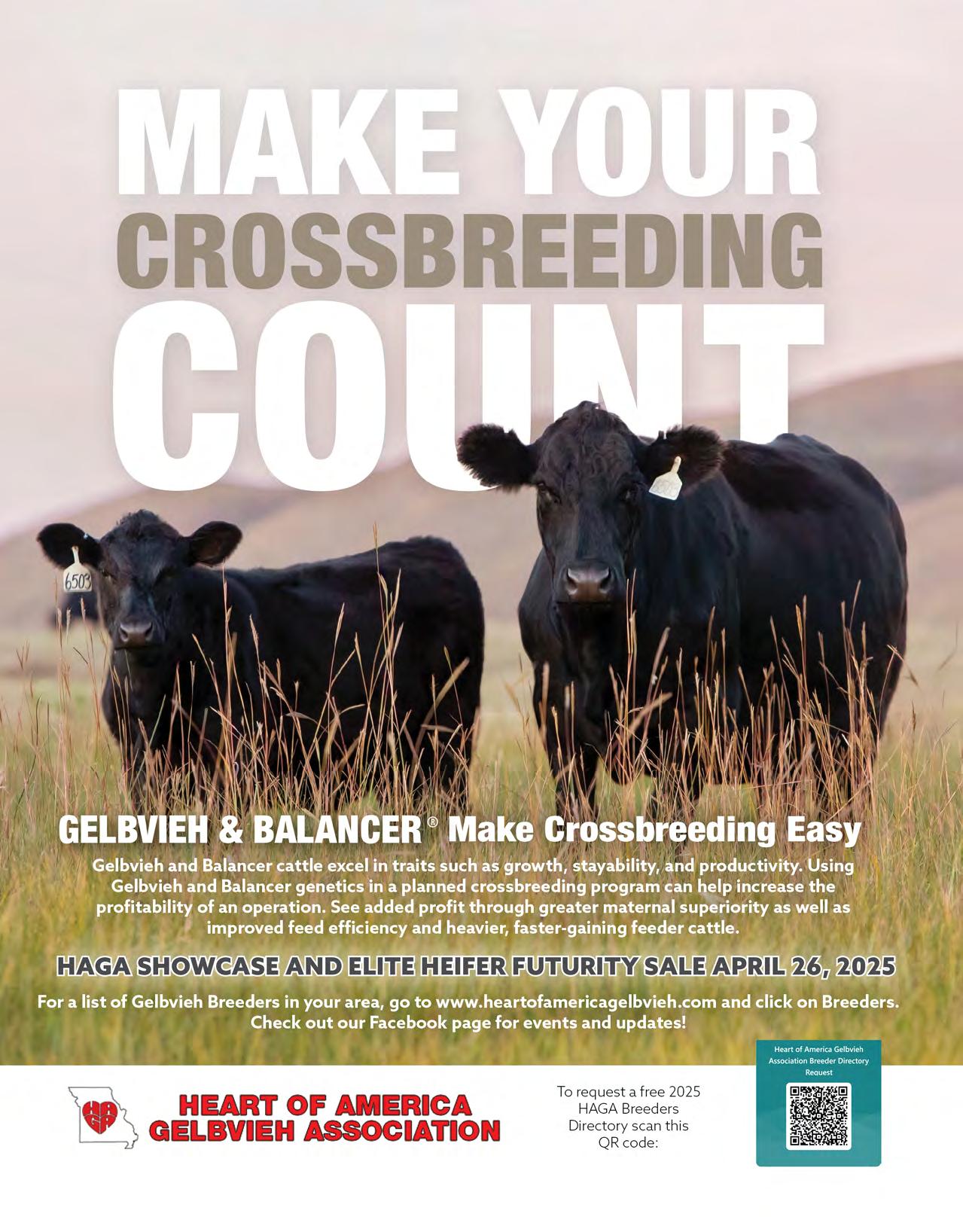
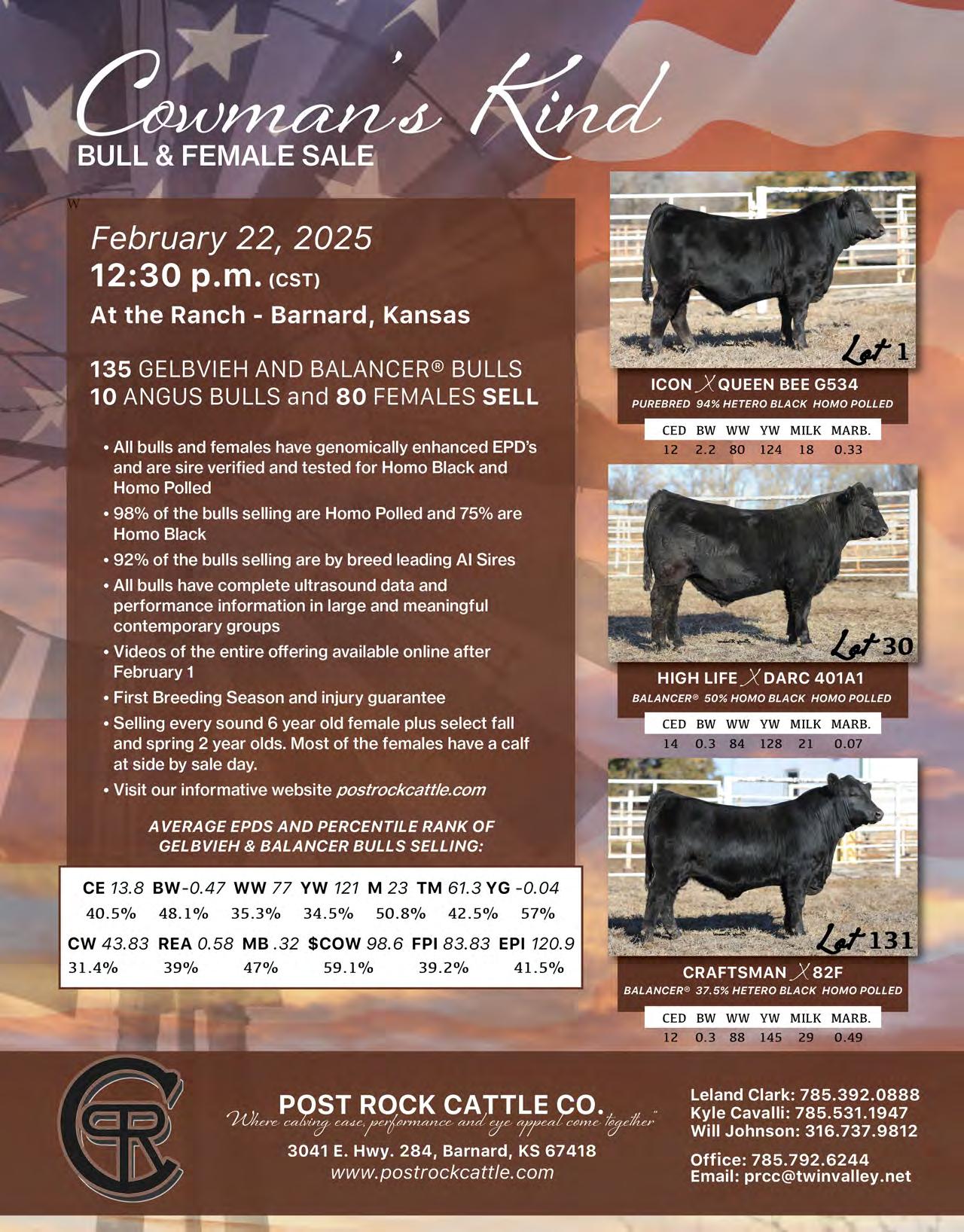
Source: University of Missouri Extension
COLUMBIA, Mo. – Improving fertility in cows involves leveraging genetic selection and advanced genomic tools to enhance reproductive performance.
But genetic potential is only half the battle. Environment is the other half, said University of Missouri Extension state beef genetics specialist Jamie Courter at the recent Missouri Livestock Symposium in Kirksville.
“Fertility is a lowly heritable trait; therefore, a lot of environmental factors can negatively impact a female with otherwise high genetic merit,” Courter said.
An animal’s phenotype, or the traits seen, is a combination of their genotype (genetic merit) and the environment in which they are raised. Environmental factors can include both Mother Nature as well as management decisions on the farm, she said.
“We can take females with poor genetics for fertility and manage them in a way that increases their likelihood of becoming pregnant,” Courter said. “Similarly, we can take females with excellent genetics for fertility and
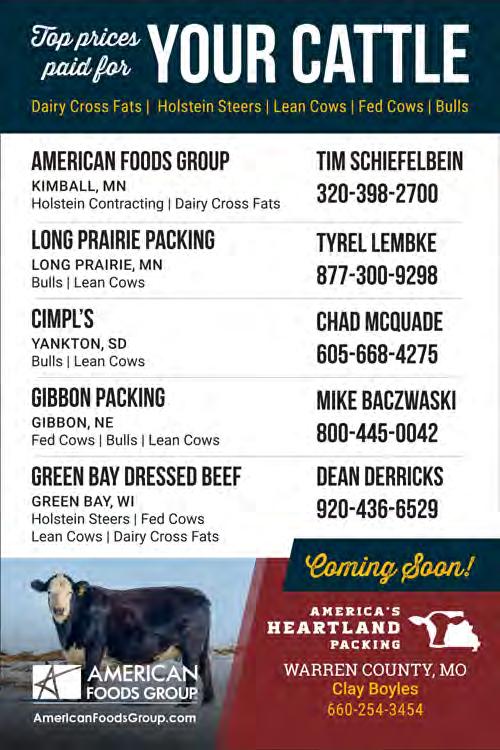
decrease their likelihood of becoming pregnant through poor management. When it comes to building better female cows, the goal should be to match their genetics to the environment.”
Because fertility is a lowly heritable trait, it is often more beneficial to focus on traits with higher heritability. When producers ask for increased fertility, they want more cows bred per year; therefore, more calves weaned. There are many other traits with higher heritability that can result in the same outcome, she said. To match genetics to the environment, the first step is to define a breeding objective. The most important question to ask yourself when creating a breeding objective is “What is the biggest revenue generation on my operation?”
• Do you sell calves at weaning (is weaning weight important)?
• Do you retain ownership and market based on carcass quality?
• Do you sell Show-Me-Select heifers? There are expected progeny differences/traits that can be selected for in these situations, and many more.
Then follow that with questions such as:
• Are there other traits important to your operation?
• Do you work cattle with your kids or grandkids? Is docility important?
• What is the environment surrounding the cattle? Requirements for females in Missouri, with higher stocking rates and smaller pasture sizes, are different than for females in the Sandhills of Nebraska who need to travel much longer distances.
• What phenotypes are critically important to match these needs – e.g., feet and leg conformation, predator protection, etc.?
Expected progeny differences are a key tool in accurately implementing successful breeding programs. They predict the genetic potential of an animal as a parent and estimate the differences in performance traits that can be expected in that animal’s offspring.
Courter said EPDs should be seen as an additional tool to help producers make informed decisions that drive their breeding objectives and match cattle to their environment.
There are three nonnegotiables when genetically selecting a better cow herd:
1. Mature cow size. “While I often hear, ‘But my larger cows wean heavier calves,’ that isn’t the right question we should be asking,” Courter said. “Instead, we should ask ourselves, ‘Are larger cows as efficient as my lighter cows?’ To which the answer is a resounding ‘no.’”
What resources did you concede to accommodate that larger cow? Cow size directly affects stocking rates. Decreasing mature cow size allows for increased stocking rates and therefore more calves weaned per year. In addition, larger mature-weight cows also take longer to reach puberty, decreasing their likelihood of conceiving in the first 21 days of the breeding season as a heifer.
2. Hair shedding. Earlier shedding cows tend to wean an older, heavier calf. (See the MU Extension publication “Hair Shedding Scores: A Tool To Select Heat Tolerant Cattle,” available for free download at https://extension.missouri.edu/publications/g2014.) A female who does not shed her hair in a timely manner doesn’t match her environment. She is stressed in some way, be it due to nutrition, heat or health. Females who don’t shed their hair early are likely to have lower body condition at breeding due to heat stress during summer and are less likely to become pregnant.
3. Calving ease. Not a “more is more” type of trait. The goal of selecting for bulls with increased calving ease is to decrease dystocia (difficult or abnormal labor) events. However, stacking increased calving-ease bulls year over year can have detrimental effects on other traits of economic importance. “The genetic correlation between birth weight and weaning weight is 0.60,
meaning that calves born smaller are typically smaller at weaning time,” she said. “This doesn’t bode well for profitability.” However, the genetic correlation between calving ease and weaning weight is only 0.32, meaning producers can select calving-ease bulls who have heavier calves at birth; therefore, are heavier at weaning. From a producer’s perspective, calving ease is a threshold of “did I have to intervene or not?” In other words, calving ease is a trait to pay attention to when selecting bulls, especially for heifers.
“However, if calving ease isn’t an issue in your herd, it may be worth discussing with myself or a trusted seedstock producer how to best manage those genetics moving forward,” Courter said.
At the end of the day, select bulls based on their genetic potential for traits of interest, she said. Use the information available to make educated decisions. Weigh the pros and cons of the bull. Normally, producers need multiple bulls, so balance out one bull’s deficit with another’s surplus.
“Before you get frustrated, realize it’s not easy. The perfect animal doesn’t exist, but we can make better decisions knowing that ahead of time instead of realizing we made the wrong decision five to seven years down the road,” Courter said.
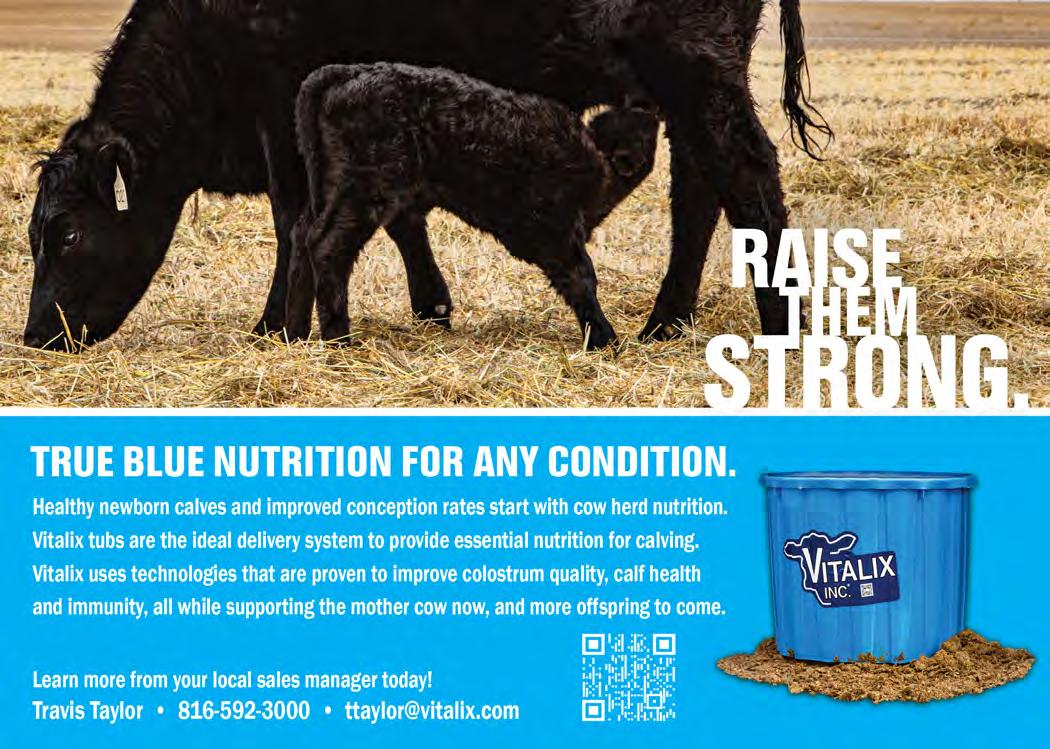
Source: University of Missouri Extension
MARSHFIELD, Mo. – Cold weather has moved into Missouri quickly with no plans of leaving soon, according to forecasts.
“It is officially winter in Missouri, and our cattle herds in southwest Missouri and beyond are feeling it,” said Chloe Collins, University of Missouri Extension dairy specialist. “Whether you’re a pasture-based dairy producer or running cow-calf pairs, knowing what to expect from prolonged extreme cold and knowing how to mitigate cold stress in your herd can help you navigate this weather with more confidence.”
Direct impact from cold
Collins says both beef and dairy cattle experience the same effects from cold weather including the following:
• Frostbite damage- Any wet or damp extremity is in danger of frostbite. Ears, tails and feet are the most at risk, and newborn calves are the most susceptible. Frostbite will start to occur at 20 degrees Fahrenheit without wind chill.

• Increased metabolic rate- During extreme cold, we can expect cattle to elevate their metabolic rate, which then increases their heat production, Collins said. That helps to raise the body temperature but will also increase appetite and feed intake.
• Reduced movement- Cattle may become harder to move during extreme cold. It is a side effect of their natural survival instinct to stay in what they’ve deemed their “protective area,” she said. They are also determined to avoid wind and areas with poor footing. If you are moving cattle, use proper handling techniques and avoid moving them too fast on slick ground.
“Another important skill a farmer needs to have during times of extreme cold is the ability to recognize cold stress in their cattle,” Collins said.
Some symptoms of cold stress include:
• Lack of snow covering their backs- Cattle with no snow on their backs when it is snowing is a definite sign of cold stress. Their coats are designed to keep heat in, so seeing snow build up on the animal means that the heavy winter coat is doing its job.
• Behavior changes- When it is cold, cattle will start to form tight huddles and look generally uncomfortable. If you’re seeing this in your herd, it may be time to find a location with more shelter or wind blocks. The more time they spend huddled up, the less time they’re spending eating.
• Other signs- These signs may not be as easy to observe from across the pasture. If you’re able to get close to your cattle, look at their breathing rates and see if they are shivering. Cattle that are cold will take deeper breaths and overall have decreased respiration. They will also shiver to generate more body heat.
MU Extension livestock specialist Elizabeth Picking shares tips on preparing your herd:
• Provide windbreaks- Wind chill can increase cold stress. Providing windbreaks can minimize cold stress. Lean-tos, barns, trees, stacked bales, hollows or bottoms, or even brushy fencerows can act as windbreaks. Feeding hay or feed in areas where wind is blocked also helps to get your herd to spend time in those areas.
• Provide cover from rain- Cattle’s ability to stay warm is drastically reduced when they are wet. When low temperatures, rain or sleet are expected be sure to give them access to cover by way of lean-tos, barns or tree cover.
• Feed extra long-stem forage- One of the byproducts of hay and grass digestion is heat. The microbes in the rumen of cattle produce more heat when fed forage or other more fibrous feeds rather than starchy feeds like corn and pelleted grain. To take advantage of this heat produced by digestion, feed larger amounts of goodquality hay during cold periods.
• Provide bedding- Straw, hay, wood shavings, rubber mats or even mulch can be a great way to keep stock warmer during cold snaps. This is especially important if the ground is wet and muddy or your herd has small calves that do more lying down than adults and can lose body heat more easily due to their larger surface area to body mass ratio. Bedding also reduces the risk of frostbite to ears, tails, feet and testicles.
• Provide adequate access to unfrozen water. It’s always a chore during cold weather, but it is very important. When it’s cold, cattle should be consuming one gallon of water per 100 pounds of body weight per day. Dehydrated animals can have a harder time regulating their temperatures. Frost-free waterers or heated waterers are good options. Access to electrolyte, mineral or salt mixes can encourage cattle to drink more water.
In addition, check your insurance policy on your cattle and see what your coverage is for winter weather-related events.
“Unfortunately, cattle are more susceptible to the cold than we may sometimes see, so it’s always a good idea to have extra protection ready for the unexpected,” said Picking.
If you have questions on how to prepare for and care for your herd during extreme cold, contact Chloe Collins at chloecollins@missouri.edu or Elizabeth Picking macconnelle@missouri.edu.

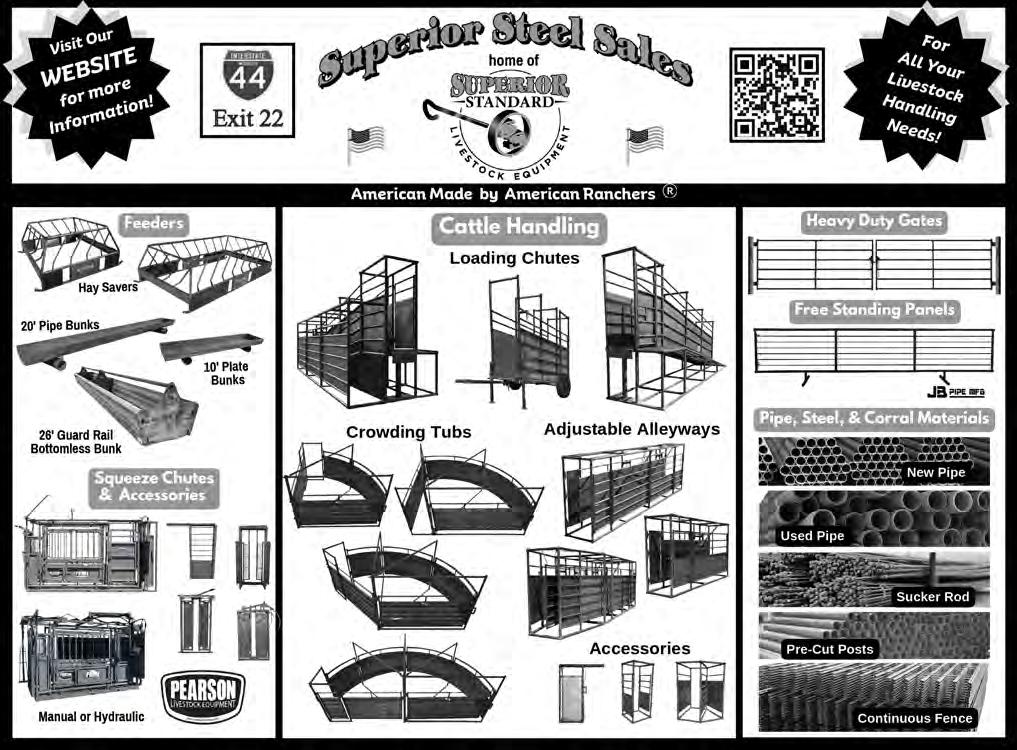
Interactive sessions are designed to sharpen marketing and business skills.
Source: University of Missouri Extension
COLUMBIA, Mo. – Small-scale food and farm entrepreneurs face unique challenges with business planning and marketing. To help meet these needs, University of Missouri Extension is launching Growing Success: Marketing and Business Development for Small Farms. This will run throughout March. The evening webinar series is designed to equip attendees with practical skills and resources for success.
“We meet many producers who have innovative ideas and undeniable passion,” said Mallory Rahe, MU Extension associate professor and webinar series organizer. “The challenge often lies in putting strategy behind those ideas to make them feasible long-term.”
The series begins March 4 with Cultivating Connections: Strategically Market Your Food and Farm Products. Attendees will learn how to communicate their unique value with an elevator pitch, craft target customer profiles, and use digital avenues when building a marketing strategy.
“Marketing is a common pain point for many entrepreneurs who are already wearing many hats in their business,” said TaylorAnn Washburn, MU Extension communications strategist and Cultivating Connections webinar host. “Our goal is to make marketing more approachable and highlight how a bit of strategic work in the forefront can increase overall efficiency and impact.”
The series continues on March 11 with Will It Work? Assessing New Farm Products, a two-hour interactive session focused on evaluating new product ideas. MU Extension agricultural business specialist Katie Neuner will show participants how to use online tools like AgSite and Intel for Ag for informed decision-making.
“This session is perfect for beginners and those ready to add a new farm enterprise, like elderberries or pastureraised pork,” Neuner said. “We hope that attendees leave with knowledge and confidence to assess the potential success of their product idea.”
Following the marketing-focused session is What Does It Cost My Farm To Sell in Different Markets? On March 18, Rahe will walk participants through the Market Channel Cost Assessment Tool to understand how to estimate marketing costs and inform product pricing decisions as they sell at farmers markets, CSAs or wholesale.
The series wraps up March 25 with Five Key Considerations as You Scale Your Business. Participants will walk through an interactive checklist to assess readiness for growth by first setting a tangible business goal and then discussing financial capacity, labor needs, operational efficiencies and other critical factors. MU Extension agricultural business specialist Denice Ferguson will guide participants through this comprehensive planning exercise.
The Growing Success series will also highlight resources available through the United States Department of Agriculture’s Farm Service Agency, a key partner in supporting producers of all scales and scope.
“FSA offers a wealth of programs and resources to help farm and food entrepreneurs as they start or expand their businesses,” said Rahe. “We want attendees to be aware of how FSA can support their journey.”
Find more information and register for the series at http://muext.us/growingsuccesswebinars.
This webinar series is supported by the U.S. Department of Agriculture’s (USDA) Farm Service Agency through project award number FSA23CPT0012862.

Source: University of Missouri Extension
COLUMBIA, Mo. – University of Missouri experts have released the Show-Me 2025 Missouri Agricultural Outlook, which shows a mixed outlook for Missouri’s crops and livestock and the challenges and opportunities ahead.
The report is available at https://mizzou.us/MAO25.
“While corn production is set to decline with rising prices, soybean production is expected to increase despite falling prices,” said Danyelle Chinn, economist with the University of Missouri Rural and Farm Finance Policy Analysis Center. “On the livestock side, declining beef cow inventories may push cattle prices higher, while increasing hog inventories could lower prices.”
These trends emphasize the need for strategic decisionmaking in a shifting market, Chinn said.
“In addition, RaFF projected Missouri’s net farm income to decline by $697 million in 2024 and an additional $0.7 billion in 2025, primarily due to falling crop receipts and reduced crop insurance payments,” she said. “This highlights a challenging financial landscape for farmers.”
There is a silver lining, however, said RaFF Director Alejandro Plastina.
“The $391 million in economic assistance to Missouri crop producers through the American Relief Act of 2025 will inject the equivalent of 6% of the projected crop cash receipts, increasing the projected net farm income from all farm-related activities in 2025 by 14%,” Plastina said. “However, since the geographical distribution of payments will vary substantially across counties, it is important that crop producers calculate their own projected payments to plan their cash flow needs accordingly using RaFF’s decision tool.” The spreadsheet tool is available for download at https:// mizzou.us/AFA25calc.
• Missouri farm income is projected to decline to $2.9 billion in 2025 as lower crop and livestock receipts outweigh reductions in production expenses.
• Missouri’s production expenses are projected to decline by 3% in 2025, to $11.7 billion, driven by further reductions in feed and seed costs, fertilizer, pesticides, fuel and oils, labor, interest rates and overhead expenses.
• Missouri’s crop sector faces mixed prospects for the coming year. Corn production is expected to decline, although prices are projected to rise due to market conditions. In contrast, soybean production is set to increase despite a decrease in prices. Other crops, such as cotton, hay and rice, may see reduced production levels, with mixed price trends.
• Missouri’s livestock sectors are also a mixed bag. Beef cattle inventories are expected to decline, driving prices higher, while hog inventories are rising, potentially lowering prices. The dairy sector faces challenges from lower milk prices and a decline in milk cow inventory, while turkeys and broilers are projected to see steady growth, with mixed price signals. Egg production is projected to increase, causing a decline in egg prices.
• Total farm cash receipts are projected to decline in 2025, reflecting lower crop prices for certain commodities and adjustments in livestock revenues. The drop in cash receipts will likely pressure farm finances, emphasizing the need for strategic planning to maintain profitability.
Missouri’s agriculture sector generates nearly $94 billion each year, making it a cornerstone of the state’s economy, Chinn said.
“This report highlights the importance of supporting the agriculture industry, which is essential to both the state’s economic stability and global food security,” she said. “It provides a roadmap for understanding the challenges and opportunities ahead for Missouri’s agriculture industry.”
Every Monday: Slaughter Cattle 12:00 p.m.
Selling All Classes of Cattle 12:30 p.m.
1st Thursday Nite of Each Month: 6:00 p.m. Bred Cows and Breeding Bull Sale
Jack Harrison 573-999-7197 (owner)
John P Harrison 573-220-1482
Claude Niemeyer 573-470-1017
Roger Temmen ................. 573-680-4538
Justin Oberling 217-440-7724
Glenn Stegman 573-619-8495


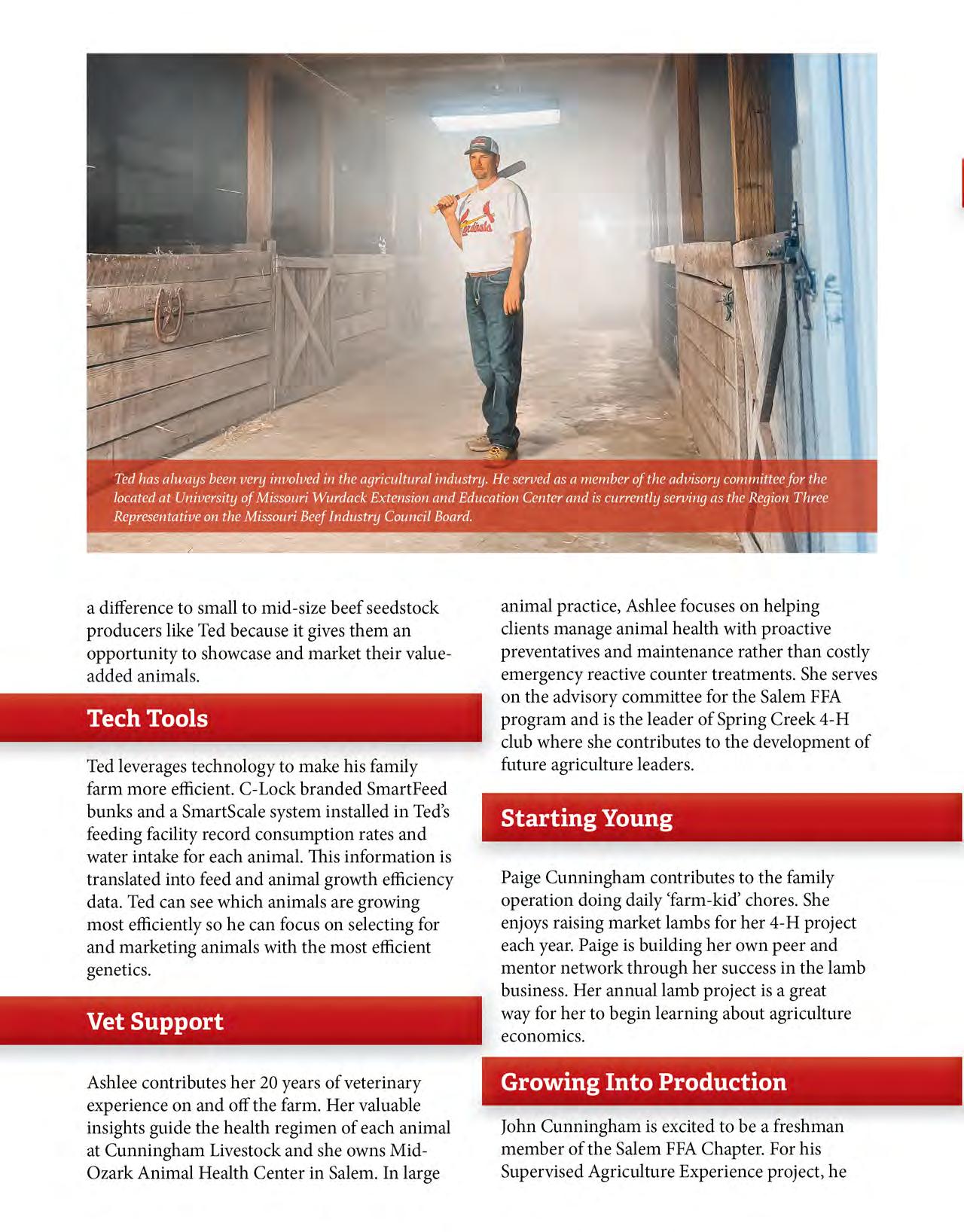




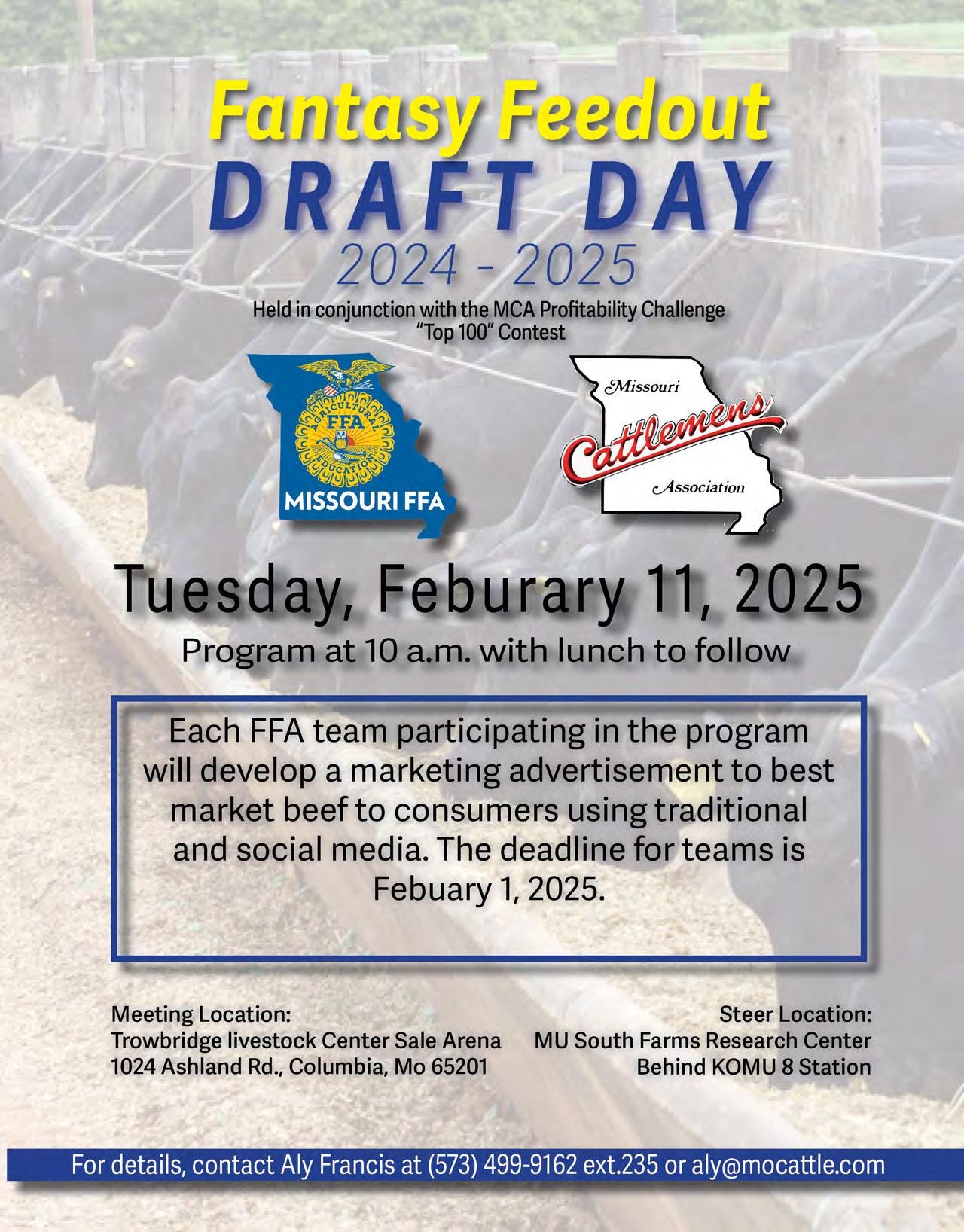

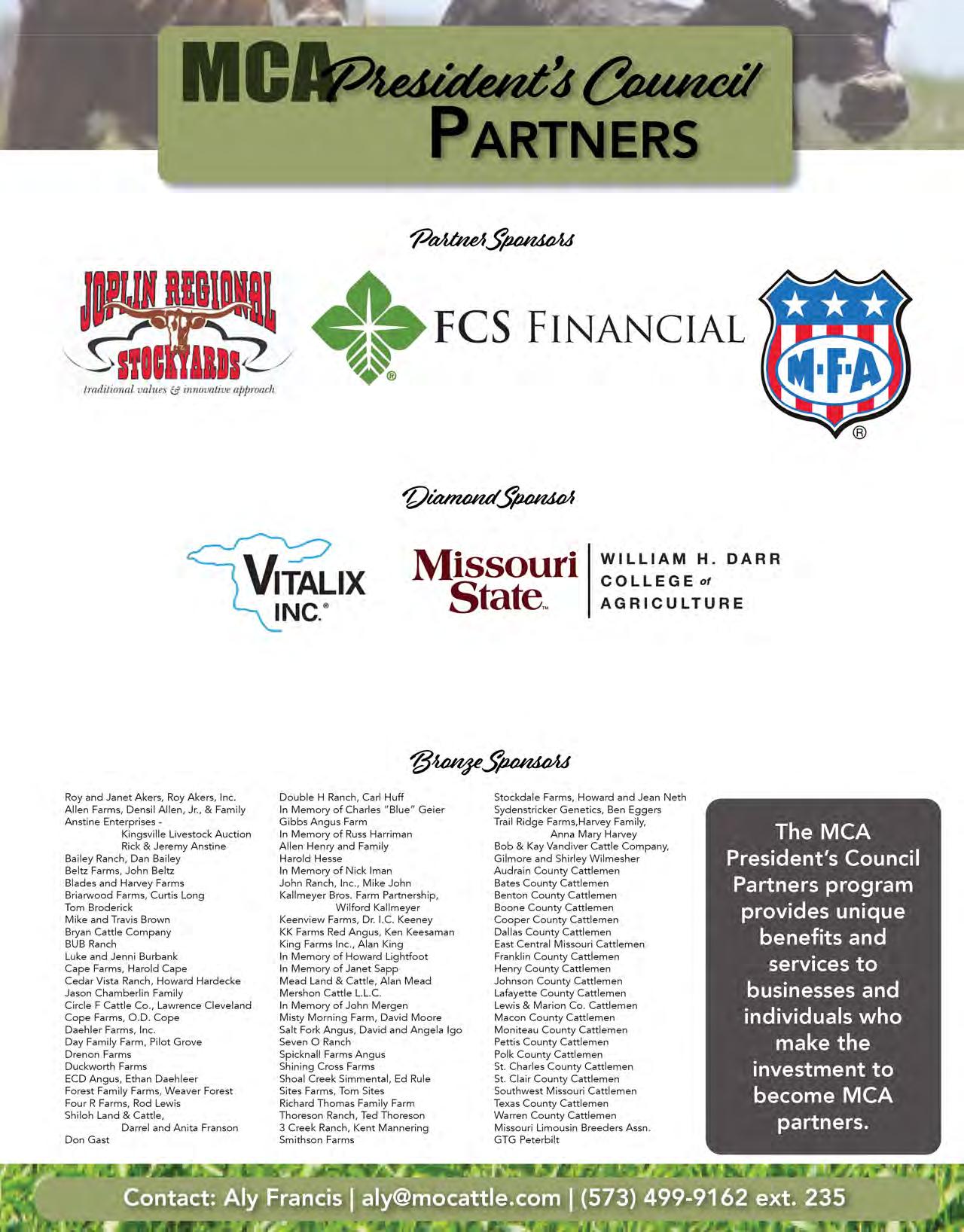
Cooper and I are incredibly honored to receive the Missouri Cattlemen’s Association Allied Industry Award at last month’s convention. The recognition is deeply meaningful to us, and we want to dedicate this article to express our gratitude to each of you, the Association, and the cattle industry.
First, thank you to the Missouri Cattlemen’s Association for everything you do to support and advocate for cattle producers across the state. Your work and commitment are vital to those who are directly involved in the cattle business, those who consume our products, and Missouri agriculture as a whole. It’s an honor to collaborate with such a hardworking and passionate group of individuals.
When we reflect on our time working alongside MCA and its members, we see countless examples of teamwork, innovation, and resilience. This award isn’t just a reflection of our contributions, it highlights the strength and commitment of everyone with whom we’ve had the privilege of working. From navigating policy challenges to strengthening support for the industry we love so much, every success we’ve shared has been a true team effort.
As we enter another legislative session, we promise to match your dedication and will fight to ensure MCA has a strong voice in shaping policy. We will work to protect
Service age bulls, bred cows, cow/calf pairs, show prospect heifers available. 417-652-3425 417-839-7205 www.oryscircle7.com
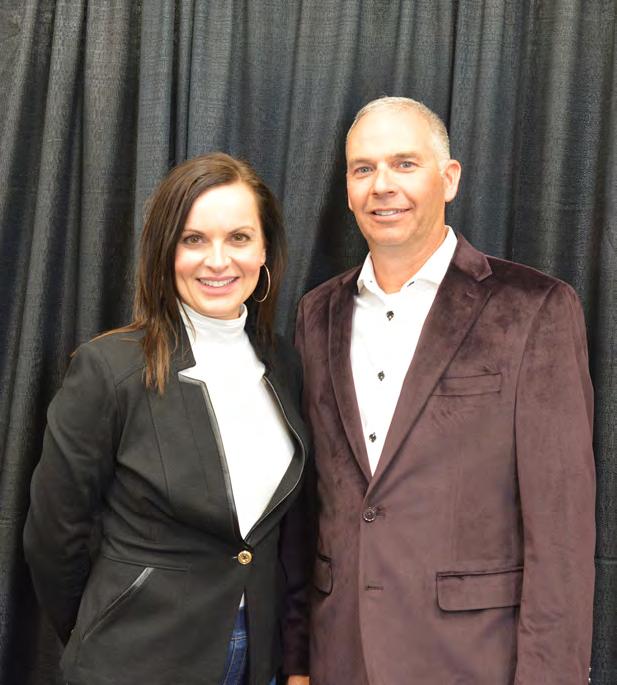
your water resources, enhance your property rights, and ensure solar farms are taxed appropriately. While we cannot promise a result, we will promise to do our utmost to make your lives a bit easier.
Missouri’s cattle industry has a special place in our hearts. It’s not just a cornerstone of our state’s economy; it’s a way of life for so many families including our own. We admire the dedication and perseverance of our farmers and ranchers who work day in and day out to care for their livestock, protect their land, and provide for their communities. You are the foundation of everything we do.
Thank you once again to the Missouri Cattlemen’s Association for this incredible recognition. We are truly grateful for the opportunity to represent you in the Capitol and to contribute to an industry that we care so much about. Most of all, thank you to the farmers, ranchers, and MCA members who inspire us each day with your hard work and dedication.
Here’s to continuing our work together and keeping the Missouri cattle industry strong for generations to come.
With our utmost gratitude,
Nancy and Cooper





Feb. 1
Feb. 8
Feb. 15
L oonan Stock Farm 50th Anniversary Production Sale, Corning, IA
J&N Black Hereford Production Sale, L eavenworth, KS
Byergo Angus Sale, Savannah, MO
Feb. 22 S eedstock Plus North Missouri Bull Sale, K ingsville, MO
Feb. 22 Post Rock Cattle Co. Annual Bull and Female Sale, Barnard, KS
Feb. 22 Missouri Angus Breeders Futurity Sale, Columbia, MO
Feb. 28 Jamison & Friends L1 Hereford Bull Sale, Quinter, KS
March 1 Seedstock Plus Arkansas Bull Sale, Hope, AR
March 1 Mead Farms Spring Sale, Versailles, MO
March 1 M issouri Select Genetics Production Sale, K eytesville, MO
March 1 Gibbs Farms Sale, Ranburne, AL
March 1 Moriondo Farms & MM Cattle Co.
Spring Turn-Out Sale, Mt. Vernon, MO
March 3 Buck Ridge Cattle Co. Sale, S eymour, MO
March 7 Express Ranches Spring Bull Sale, Yukon, OK
March 8 Seedstock Plus Red Reward Bull & Female Sale, Osceola, MO
March 8 Sampson Cattle Co. Annual Bull Sale, Kirksville, MO
March 8 Wright Charolais Bull Sale, Kearney, MO
March 8 Soaring Eagle Farms Bull Sale, Springfield, MO
March 8 H illtop Farms Gelbvieh & Balancer Bull & Female Sale, JRS, Carthage, MO
March 9 Flickerwood Angus Sale, Jackson MO
March 11 Galaxy Beef Sale, Macon, MO
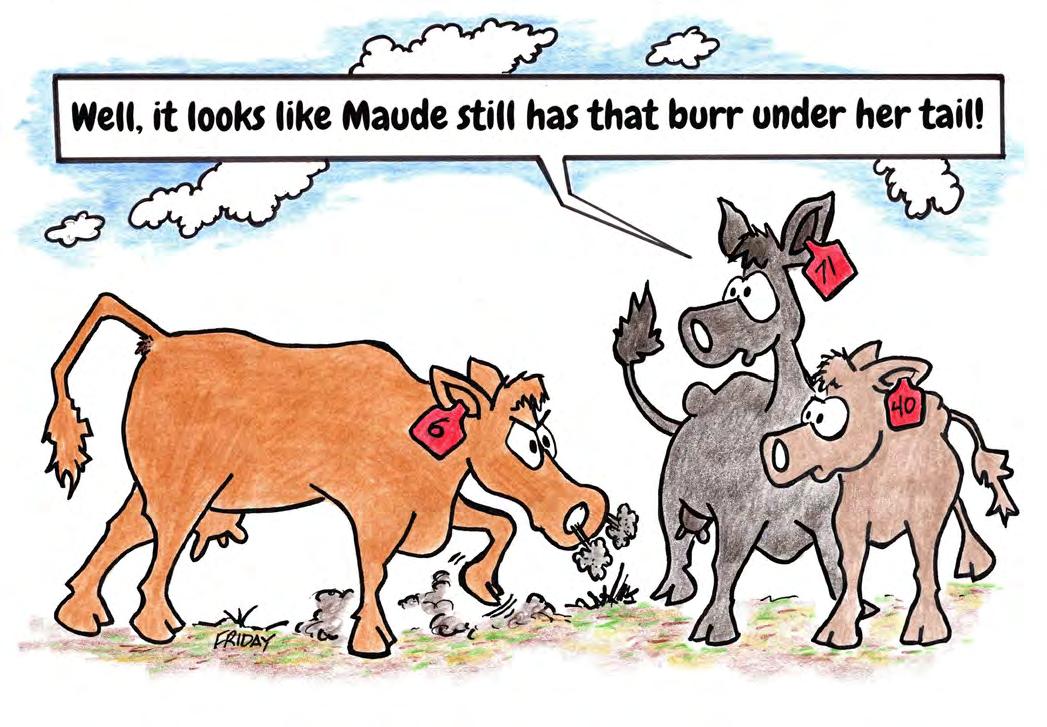
March 13 Henke Farms Sale, Salisbury, MO
March 15 Valley Oaks Spring Sale, Warsaw, MO
March 15 Falling Timber Farm Sale, Marthasville, MO
March 15 Brinkley Angus Ranch Sale, Green City, MO
March 15 Express Honor Roll Sale, Yukon, OK
March 15 Mississippi Valley Angus Sale, Cuba, MO
March 15 Bradley Cattle Bull & Bred Female Sale, Springfield, MO
March 15 Windy Hill Charolais Open House, Cedar Hill, MO
March 15 Wild Indian Acres Annual Spring Bull Sale, Carthage, MO
March 15 Northeast Arkansas Angus Association Sale, Cord, Arkansas
March 15 Er tel Cattle Co. Production Sale, K irksville, MO
March 16 Briarwood Angus Farms Spring Sale, Butler, MO
March 16 A pril Valley Farms Sale, L eavenworth, KS
March 17 Hinkle’s Prime Cut Angus Sale, Nevada, MO
March 21 Marshall & Fenner Angus Sale, Boonville, MO
March 21 Bradshaw Ranch Bull Sale, Palmyra, MO
March 22 Seedstock Plus South Missouri Bull & Female Sale, JRS, Carthage, MO
March 22 Worthington Angus Sale, Dadeville, MO
March 22 Sa ndhill Farms Sale, Haviland, KS
March 22 8 Story Farms 4th Annual Production Sale, Gallatin, MO
March 24 Oleen Brothers Production Sale, D wight, KS
March 28 Barrett Cattle & Mill Brae Ranch Annual Bull Sale, Maple Hill, KS
March 29 3C Cattle Co Sale, Carrollton, MO
March 29 R ogers Cattle Co. & Lile Farms Red A ngus Sale, Strafford, MO
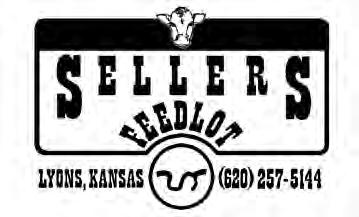
April 3
April 4
April 5
April 5
April 5
April 5
Hunter Angus Show Heifer Sale, Fair Grove, MO
Meyer Cattle Co. Sale Bowling Green, MO
Four State Angus Association Sale Springfield, MO
Gardiner Angus Ranch Spring Production Sale, Ashland, KS
Peterson Farms Bull Sale, Mountain Grove, MO
Gilbert Cattle Co Sale, Oldfield, MO
April 5 T he Gathering at Shoal Creek Sale, Excelsior Springs, MO
April 7
April 8
Brockmere Sale, New Cambria, MO
Sydenstricker Influence Sale, New Cambria, MO
April 12 Fink Beef Genetics Sale, Randolph, KS
April 17-18 NextGen Cattle Co. Flint Hills Spring Classic Sale, Paxico, KS
April 19 New Day Genetics Sale, Salem, MO
April 26 Heart of the Ozarks Angus Sale, West Plains, MO
April 26
Cow Camp Ranch Turn Out Sale, L ost Springs, KS
The MBC Classified column appears monthly. Classified advertising is only 50¢ per word. Send your check with your ad to Missouri Beef Cattleman, P.O. Box 480977, Kansas City, MO 64148. Deadline 15th of month before an issue.
“REESE” DISC MOWERS, CADDY V-RAKES, “REESE” TUBE-LINE BALE WRAPPER, AITCHISON DRILLS, SELF-UNLOADING HAY TRAILERS, HEAVY DUTY BALE AND MINERAL FEEDERS, FEED BUNKS, BALE SPIKES, CONTINUOUS FENCING, COMPLETE CORRAL SYSTEMS, INSTALLATION AVAILABLE: Tigerco Distributing Co. 660-645-2212, 800-432-4020 or www.tigercoinc.com.
BLACK SIMMENTAL BULLS SINCE 1993: Calving Ease, Attractive, Athletic, Sound Footed and Docile. We Deliver. Mike Williams, Higginsville, 816-797-5450
SYCAMORE CREEK SIMANGUS BULLS & BRED HEIFERS FOR SALE. Great EPDs. Wayne and Anita Vanderwert -15 minutes from Columbia. 573-808-3000 or 303-506-3508
HORNED HEREFORD BULLS. Large frame, add weaning weight and good disposition. 10 miles south of Warrensburg. ET Herefords. David Bernt 660-238-2395. Tim Bernt 816-517-4102.
